#the conservation of marine and ocean sea-dwelling animals
Text
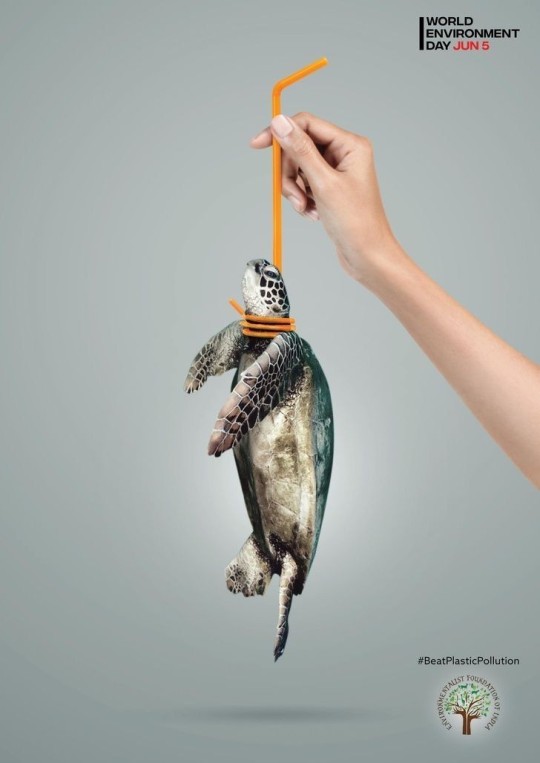
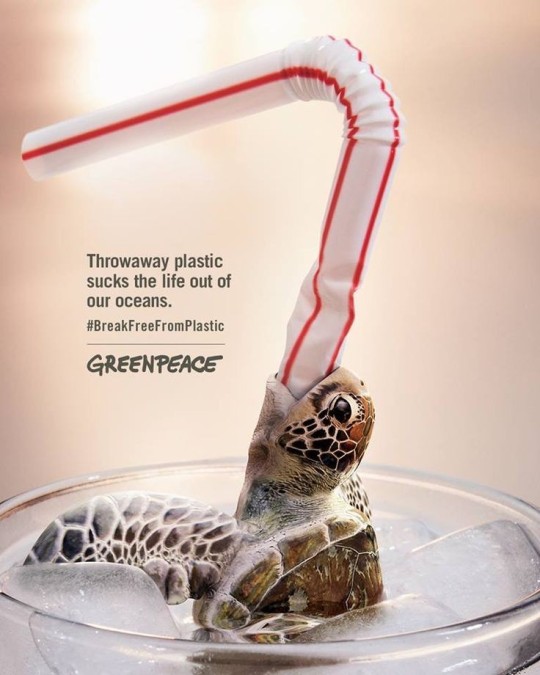

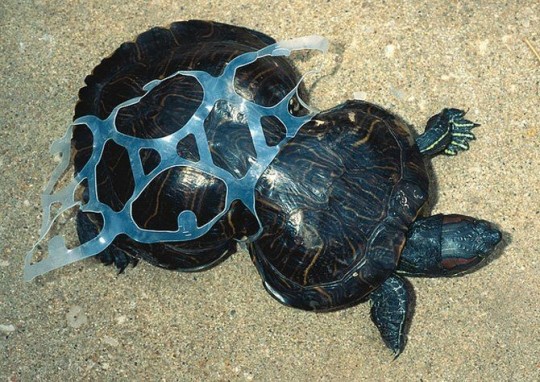

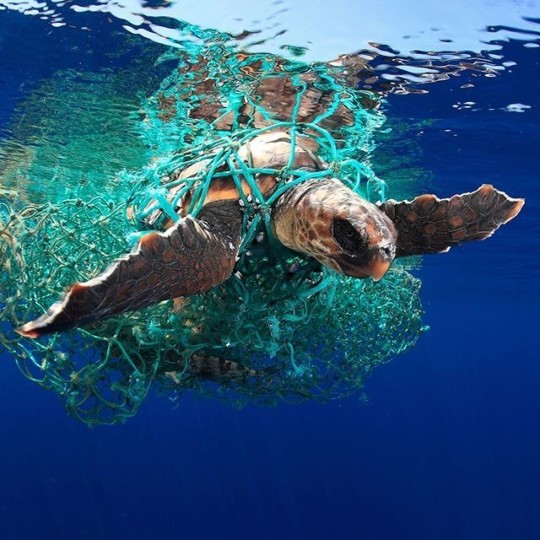
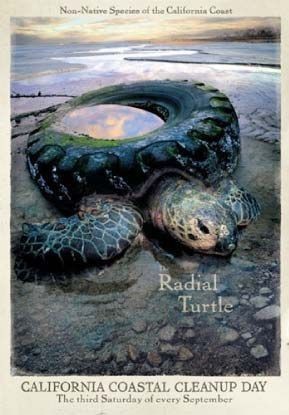



The way it's going Ocean turtles don't have any hope of several from this plastic genocide that know one cares to talk about something needs to be dun to preserve these majestic docile creatures that share their oceans with us because they have no big plants they're they're harmless and they rid our oceans of jellyfish they eat jellyfish
#green tortis bus#sexy celebrities#sexy ce#tumblr milestone#green peace#ocean and marrean animal hospital#the conservation of marine and ocean sea-dwelling animals#Spotify
2 notes
·
View notes
Photo


Boneworms (Osedax spp.)
Family: Siboglinid Worm Family (Siboglinidae)
IUCN Conservation Status: Unassessed
First discovered in February of 2002, the roughly 26 species of typically deep-sea dwelling worms in the genus Osedax (known commonly as boneworms, bone-eaters, bone-eating worms or zombie worms) are noted for the extremely specific ecological niche they occupy: when a whale dies and the blubber that aids it in controlling its buoyancy begins to break down, its remains will sink to the sea floor and (depending on where the whale died and the circumstances of its sinking), they may sink to extreme depths where most marine scavengers cannot find them (an event known as a whale fall), with the whale’s soft tissues providing food for a variety of unique deep-sea scavengers for decades at a time. Once the soft tissues have been consumed the whale’s skeleton is left largely intact, at which point the larvae of female Boneworms come to settle on it and develop into their adult forms: small, pale worms with no mouth or digestive tract, but with a network of superficially root-like structures at their base which allows them to anchor themselves onto the skeleton and gradually bore into it. The “roots” of a female boneworm house unique bacteria that live in a mutualistic relationship with the worm, living in the worm’s tissues and secreting substances capable of breaking down the bones of the whale, releasing nutrients into the water that the boneworms absorb directly across their epidermis (the outermost layer of their body,) which is lined with tiny structures similar to the villi in the small intestine that maximizes the worm’s surface area and allows for more efficient absorption of nutrients. The body of a female boneworm is lined with a protective mucus that prevents the substances excreted by the bacteria in their roots from damaging their tissues, and within this protective mucus layer lives a “harem” consisting of hundreds of tiny males, tens of thousands of times smaller than the female they inhabit, which fertilize the clutches of ova (egg cells) that she frequently releases into the water in large numbers, allowing them to develop into new larvae that can later colonize new skeletons. A single whale skeleton may come to support a large number of boneworms (with multiple species sometimes coexisting on a single skeleton), and by boring through the hard outer layers of the bones boneworms expose the softer and more nutritious inner regions (such as bone marrow) to other scavengers such as crabs, amphipods and gastropods (with some, such as the sea snails of the genus Rubyspira, relying on whale bones that have been “softened up” by boneworms as their primary source of food.) Despite the very specific conditions in which they live it seems that boneworms are abundant and surprisingly diverse (with species so-far having been found in the Atlantic, Pacific and Southern oceans), and while wild boneworms have only ever been found living in the bones of whales it has been observed that they will inhabit the bones of other animals, such as cattle, if provided with them, suggesting that they feed on whale bones less out of necessity and more because whale bones are simply the easiest large bones to find at great depths. The presence of marks that closely resemble the holes left by boneworms in the 100 million year old fossilized bones of a plesiosaur and extinct sea turtle found in Cambridge, England seems to suggest that boneworms, or at least their ancestors or relatives, have been around for considerably longer than the whales they now rely upon for food.
--------------------------------------------------------------------------
Boneworms may be a little bit eerie, but they’re also a very cool example of just how specialized animals can get, and how even the most bizarre species live complex lives and are part of wider ecosystems. The first image above shows the full body of a female of the northeastern Pacific species Osedax rubiplumus, while the second image shows several females of the southern Atlantic species Osedax braziliensis boring into a whale skeleton.
Image Source: https://www.inaturalist.org/taxa/63596-Osedax
#Boneworms#osedax#worm#worms#zoology#biology#marine biology#animal#animals#marine animals#deep-sea animals#wildlife#marine wildlife
64 notes
·
View notes
Text

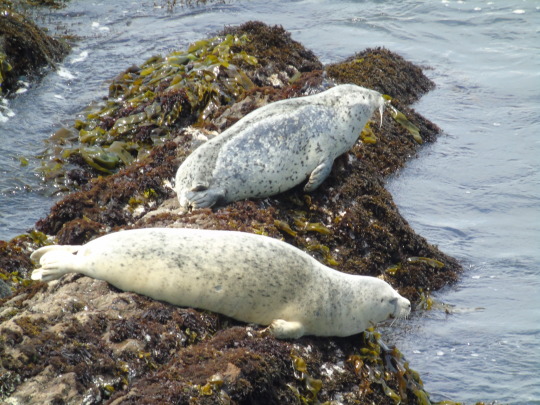
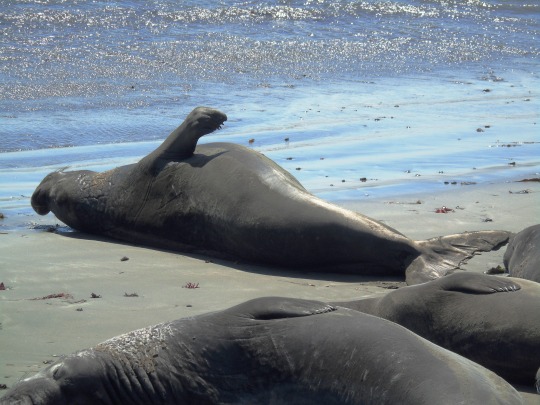

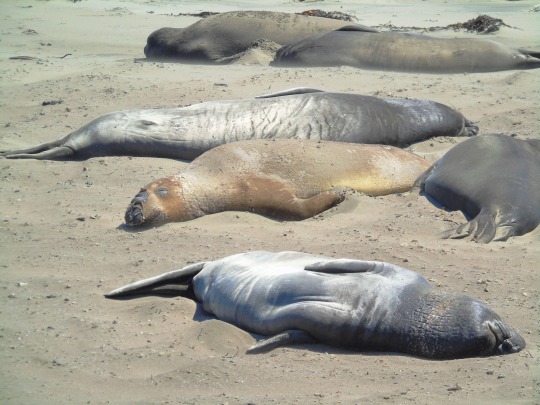
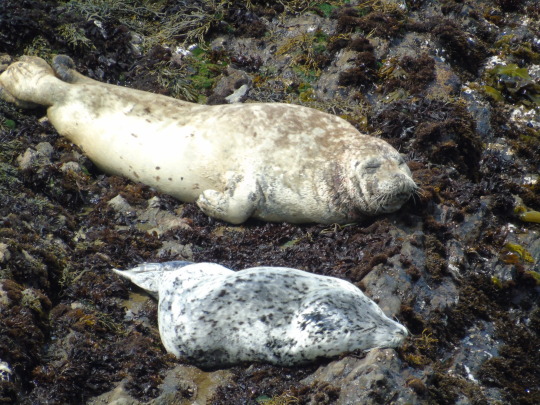
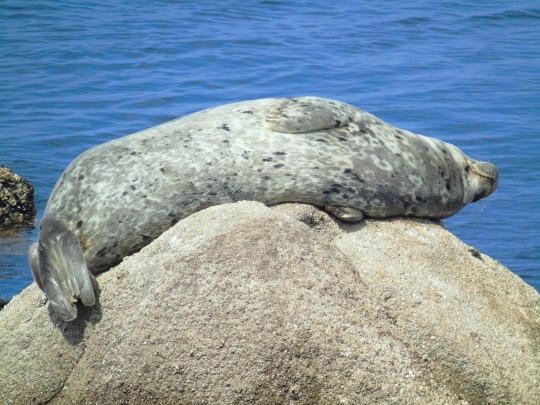
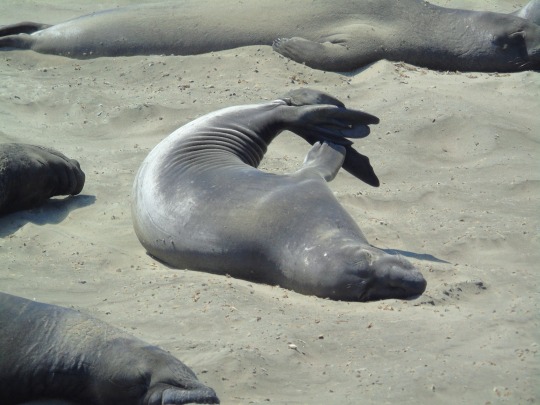
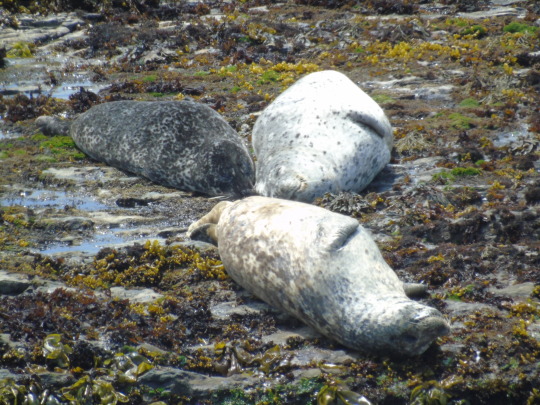









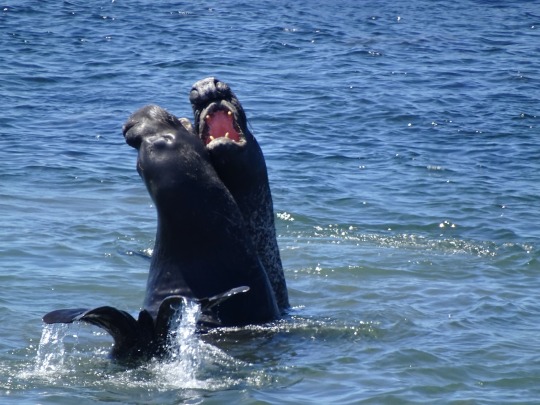





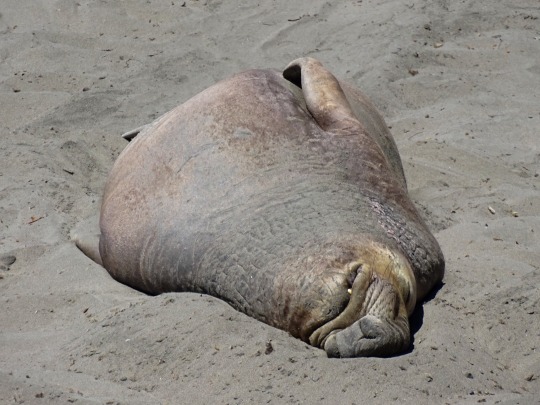
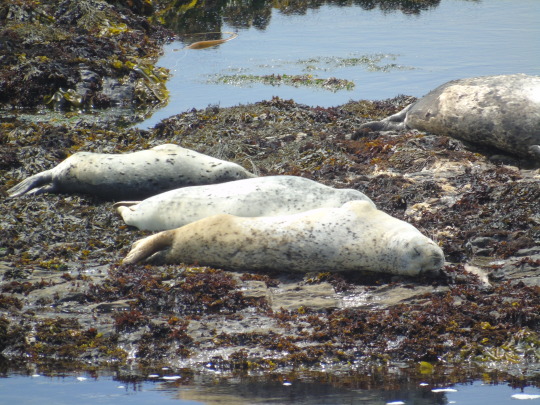

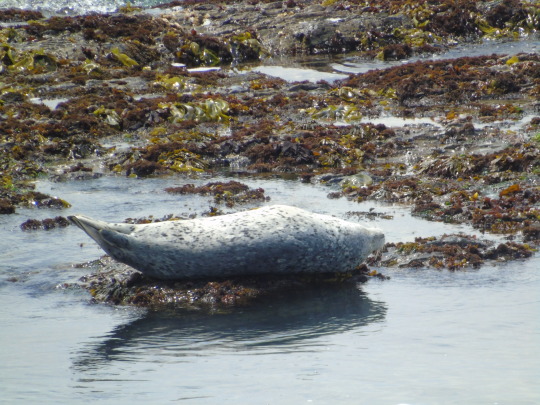
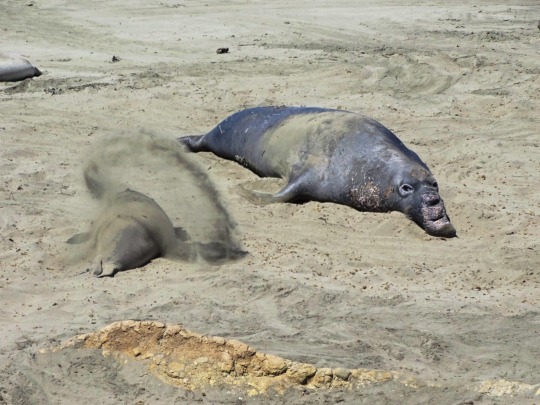
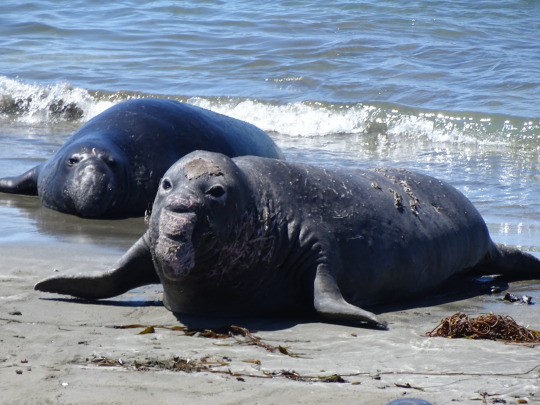
International Day Of The Seal
International Day of the Seal takes place on March 22. It is a day set aside to raise awareness about seal conservation around the world. It’s also a day for us seal lovers to honor this amazing sea mammal. Seals are not only adorable and attractive, but their presence in the world today has a significant impact. They are also the most targeted marine mammal on the planet. These creatures are in danger of soon becoming extinct. Humans have always posed a significant threat to them, as people capture them for feed, blubber, or pelts. As a result, this day is observed to emphasize the importance of preserving their population.
History of International Day Of The Seal
This international holiday was established in 1982. Since then, the holiday has been observed yearly on March 22. The total number of seal species was already declining at the time. Seals were increasingly becoming victims of humans. This is because humans hunted seals for their pelts, blubber, and meat. To put an end to this brutality, the day was proclaimed the “Day of the Seal.” The United States Congress established the worldwide holiday to raise awareness among Americans about the plight of seals. They developed several projects to raise awareness about the importance of protecting seals.
A seal is classified as a pinniped, which means “fin-footed” in Latin. The walrus and sea lion are two other pinnipeds. Seals are distinct from other pinnipeds in that they do not walk with their flippers. They frequently move about on their bellies when on land. Their flippers assist them to move quickly in the water. Seals are also calmer and smaller than sea lions and walruses.
Seals are located around the north and south poles. They are preyed upon by predators and hunters. This has put their population at risk. This day was established to raise awareness about how they might be saved.
This day is observed all over the world. Although seals dwell in the Arctic Circle and Antarctica, millions of people around the world adore them, and so this holiday is observed globally.
International Day Of The Seal timeline
1811 Pinnipedia
Johann Karl Wilhelm Illiger names both a clan and an order Pinnipedia.
1886 The Extinction of the Seal
The animal is considered extinct until a little group is discovered near the Yucatán Peninsula.
2001 The Link Between Sea Lions and Seals
Genetic analysis reveals that the north fur seal is more closely linked to many sea lion species.
2021 Recognition By the I.U.C.N.
Thirty-six pinniped species are recognized by the International Union for Conservation of Nature (I.U.C.N.).
International Day Of The Seal FAQs
Seals descended from what animal?
The earliest progenitors of seals and sea lions were mammals that evolved from land to sea. The ocean began to cool around 36 million years ago, near the end of the Oligocene, causing major changes in ocean circulation.
Is the seal a friendly creature?
Seals look attractive and sociable, which they are. Most zoos and marine attractions portray seals as trainable, clever, and human-friendly.
Do seals have fur?
Northern fur seals have the second thickest fur on the planet, with 300,000 hairs per square inch.
How to Observe International Day Of The Seal
Attend a public awareness event
Watch a documentary about seals
Visit a seal exhibit zoo
During International Day of the Seal, many naturalist organizations and zoos host awareness events. Attend a presentation to learn more about these wonderful creatures.
There are numerous videos and reading resources available about seals and their habitat. Spend the day learning about how climate change affects these seals.
Seals are related to sea lions and walruses, which live in the Arctic Circle and Antarctica. However, you don't have to travel to the poles to meet these magnificent creatures. To celebrate the festival, you can visit a zoo and learn about them.
5 Interesting Facts About Seals
There are various species
Their skin helps with temperature
They can detect prey
They live up to 30 years
They are heavier than us
There are 33 kinds of seals.
Blubber is the layer of fat beneath the skin of seals that keeps them warm in frigid water.
A seal’s whiskers aid in the detection of prey in murky water.
Their life expectancy is 25 to 30 years.
Smaller seals weigh 100 pounds, while the largest weigh more than 7,000 pounds.
Why International Day Of The Seal is Important
It’s a week to achieve something worthwhile
It encourages study
It encourages conservation
All animals are important. International Day of the Seal allows us to perform important conservation work and identify solutions to help the planet.
International Day of the Seal encourages people to learn more about seals. It is a means of making people more aware of their place in the larger scheme of things.
The importance of conservation of vulnerable animals is emphasized on this day. Contributions to this cause are encouraged.
Source
#Point Arena#Monterey#Elephant Seals of San Simeon#habor seal#USA#summer 2022#2017#Northern elephant seal#Pacific Ocean#fauna#animal#Elephant Seal Vista Point#wildlife#International Day Of The Seal#22 March#InternationalDayOfTheSeal#InternationalSealDay#California#West Coast#original photography#tourist attraction#flora#landmark#nature#beach#travel#vacation
3 notes
·
View notes
Text
Oil Spills Around Taiwan's Marine Are Increasingly Common, With This Year's Cases More Than Doubling Previous Years

Large ships leaking oil at sea, causing oil pollution incidents, have become a terrifying threat to Taiwan's marine environment for many years.
According to statistics from the Ocean Conservation Administration of the Ocean Affairs Council of the Executive Yuan(Taiwan), from 2003 to 2023, Taiwan has experienced an average of over 27 maritime oil spill incidents per year over the past two decades. In the past decade, oil spill incidents have become even more frequent. As of September in 2023, there have been as many as 50 cases, nearly double the annual average of the previous years.

From 2003 to September 2023, there have been a total of 552 marine oil spill incidents in Taiwan, and on average, there are 27 oil spill incidents occurring each year. However, there has been a rising trend in the past decade. For instance, in 2013, there were a total of 19 incidents. By 2022, this number had surged to 51 for the full year, and in the first nine months of 2023 alone, there were already 52 incidents. A closer look reveals that these oil spill incidents are concentrated in specific counties/cities, with the top five accounting for more than half of the total cases.

Kaohsiung, Penghu, Taitung, New Taipei City, and Kinmen are the top 5 areas where oil spills incidents occur most frequently. These five areas account for 56% of the total incidents, and Level 2 and Level 3 pollution incidents have almost occurred in these regions . In the picture, bright green and bright yellow dots are locating the 2nd and 3rd level of oil spill incidents, and one dot means one independent incident.

Oil spills are hazardous as the marine ecosystem is affected, and the marine life-forms existence gets unnecessarily threatened. Since oil exploration from oceanic resources has become a must, and oil spills occur accidentally, it becomes important to employ various oil spill cleanup methods. There are chemical and physical ways to deal with oil spills.
An oil dispersant is a mixture of emulsifiers and solvents that helps break oil into small droplets following an oil spill. Small droplets are easier to disperse throughout a water volume, and small droplets may be more readily biodegraded by microbes in the water. Dispersant use involves a trade-off between exposing coastal life to surface oil and exposing aquatic life to dispersed oil. While submerging the oil with dispersant may lessen exposure to marine life on the surface, it increases exposure for animals dwelling underwater, who may be harmed by toxicity of both dispersed oil and dispersant. Although dispersant reduces the amount of oil that lands ashore, it may allow faster, deeper penetration of oil into coastal terrain, where it is not easily biodegraded. Overall, using the oil dispersant might not clean the oil spill utterly, and it is toxic to both marine life and humans, so it is being used less and less nowadays.

The use of oil booms is a straightforward and popular method of controlling oil spills. Equipment called containment booms act like a fence to prevent the oil from further spreading or floating away. Booms float on the water surface and have three parts- float chamber and freeboard, skirt, and ballast chain. The float chamber and freeboard are the part that rises above the water surface, containing the oil and preventing it from splashing over the top. A skirt is placed below the surface and keeps the oil from being squeezed under the booms and escaping. The ballast chain that connects the parts to strengthen and stabilize the boom. Connected sections of the boom are placed around the oil spill area until it is surrounded and contained.
Once the oil has been confined by using oil booms, skimmers can be deployed onto boats like pollution control vessels to remove the contaminants from the water surface. Skimmers are machines specially designed to suck up the oil from the water surface like a vacuum cleaner. They are used to physically separate the oil from the water to be collected and processed for re-use. And the “ Mailiao Marine” is Taiwan’s first pollution control vessel. It adopts a patented water tunneling system technology to suck the floating oil from the sea into the hull, and directly separates the oil and water physically to replace the traditional sorbents. The vessel can be coordinated with the EPD’s call to assist in handling marine pollution incidents.
Impact of oil spill
Because most kinds of oil are less dense than water, most spilled oil floats on the water surface and forms what is called an oil slick. It spreads out and is pushed across the water by wind, waves and currents. And the oil slick may reduce the ability of light to penetrate the ocean, and influence the air-sea exchange, causing the species in the ocean to die indirectly because there isn’t enough dissolved oxygen in the ocean.
Marine life is affected by oil spills as well. Seabirds can be especially vulnerable because the oil covers the surface of the ocean, where they feed, and washes onto beaches, fouling their nesting areas. Seabirds that float on the water surface and dive to feed can be oiled if they happen to be in the same place as an oil slick. Seabirds keep themselves warm through their feathers, and when these get oiled, the birds become chilled and often die. This is called hypothermia. Since birds preen themselves to clean their feathers, they can also ingest oil, causing illness or death. Moreover, seabirds may misidentify the area of oil spill as land or rock that can stand. In this case, they may be covered in oil and die.
Marine mammals such as seals, whales, or porpoises must surface to breathe. If they become oiled, this may irritate their eyes or skin, or they may breathe in harmful oil fumes and even suffocate. Seals and sea lions are especially at risk of oiling when their haulout or pupping areas have been oiled.
Besides, some of the components of crude oil, such as polycyclic aromatic hydrocarbons (PAHs) like benzene, benzene and xylene, can be highly toxic to sea creatures and humans and can be accumulated and transferred up through food webs. And this is called biomagnification. According to the studies, these toxic polycyclic aromatic hydrocarbons (PAHs) are harmful to the kidney and liver which may cause disease or cancer.

According to Dr. Yi-Ching Chen of the Department of Environmental Engineering at Da Yeh University, there are four types of coastal oil pollution. These are very light oil, light oil, medium oil and heavy oil.
Very light oils are mostly used in automobiles and do not require the use of degreasing agents because of their rapid volatility. Spills do not cause bioaccumulation, but still have a regional ecological impact. Light oils are mainly used in fishing vessels and are moderately volatile with two-thirds of the oil evaporating within a few days of a spill. Some of the oil can be removed without the use of degreasing agents, but there will be long-term impacts on the intertidal zone, especially underwater.
Aircraft are often fueled by neutral oils, only one-third of which evaporate within a day, so degreasing agents are required one to two days after a spill. In the event of a neutral oil spill, there will be serious long-term contamination of intertidal areas and impacts on waterfowl and fur-bearing mammals.
Heavy oils are mostly used on ships and are the main contributor to marine oil spills. Only a small portion can be decomposed and volatilized, the use of degreasing agents is ineffective, weathering is slow, and shoreline cleanup is difficult. It will produce pollution during the growing period of sedimentation, and water birds and hairy mammals may even have serious impacts such as accidental feeding.
0 notes
Text
Blue Blood From Horseshoe Crabs Is Needed For Medicine, But A Declining Bird Relies On Crabs To Eat
The blood of the horseshoe crab provides a valuable medical product critical to maintaining the safety of many drugs and devices used in medical care. A protein in the blood called Limulus Amebocyte Lysate (LAL) is used by pharmaceutical and medical device manufacturers to test their products for the presence of endotoxins, bacterial substances that can cause fevers and even be fatal to humans. The LAL test is one of the most important medical products derived from a marine organism to benefit humans.
Why is the Horseshoe Crab the original "blue blood"? A horseshoe crab's blood has a blue to blue-green color when exposed to the air. The blood is blue because it contains a copper-based respiratory pigment called hemocyanin.
— Patrick Whittle | Monday 31 July, 2023 | Associated Press

Gulls gather around horseshoe crabs spawning at Reeds Beach in Cape May Court House, N.J., Tuesday, June 13, 2023. The biomedical industry is adopting new standards to protect a primordial sea animal that is a linchpin of the production of vital medicines. But conservationists worry the new approach still doesn't go far enough in protecting horseshoe crabs that are a food for a declining bird species. (AP Photo/Matt Rourke)
Portland, Maine (AP) — The horseshoe crab has been scuttling in the ocean and tidal pools for more than 400 million years, playing a vital role in the East Coast ecosystem along with being a prized item for fishing bait and medical research.
Its blue blood is harvested for medical researchers and used by drug and medical device makers to test for dangerous impurities in vaccines, prosthetics and intravenous drugs. The crabs are used by fishing crews as bait to catch eels and sea snails. And their eggs are a critical food for a declining subspecies of bird called the Red Knot – a rust-colored, migratory shorebird listed as threatened under the Endangered Species Act.
The competing interests have set up a clash among researchers, fishing crews and environmentalists over new protections designed to keep more of the crabs in the environment. The animals are drained of some of their blood and returned to the shore, but many die from the bleeding. And a drive to create synthetic alternatives has yet to succeed in phasing out the crabs from use.
“Everything You Do In Life Comes From Horseshoe Crab Blood. Vaccines, Antibiotics And So Much More.”
Recent revisions to guidelines for handling the animals should keep more alive through the process, regulators said. The animals — not really true crabs but rather more closely related to land-dwelling invertebrates such as spiders and scorpions — are declining in some of their East Coast range.
"They were here before the dinosaurs," said Glenn Gauvry, president of Ecological Research & Development Group, a Delaware-based nonprofit that advocates for horseshoe crab conservation. "And they’re having problems because the new kids on the block, us, haven’t learned to appreciate the elders."
The harvest of horseshoe crabs has emerged as a critical issue for conservationists in recent years because of the red knot. The birds, which migrate some 19,000 miles (30,577 kilometers) roundtrip from South America to Canada and must stop to eat along the way, need stronger protection of horseshoe crabs to survive, said Bethany Kraft, senior director for coastal conservation with the Audubon Society.
Kraft and other wildlife advocates said the fact the guidelines for handling crabs are voluntary and not mandatory leaves the red knot at risk.

Horseshoe crabs spawn at Reeds Beach in Cape May Court House, N.J., Tuesday, June 13, 2023. The biomedical industry is adopting new standards to protect the sea animal that is a linchpin of the production of vital medicines. (AP Photo/Matt Rourke)
“Making sure there is enough to fuel these birds on this massive, insanely long flight is just critical,” Kraft said. “There's very clear linkage between horseshoe crabs and the survival of the red knot in the coming decades.”
The horseshoe crabs are valuable because their blood can be manufactured into limulus amebocyte lysate, or LAL, that is used to detect pathogens in indispensable medicines such as injectable antibiotics. The crabs are collected by fishermen by hand or via trawlers for use by biomedical companies, then their blood is separated and proteins within their white blood cells are processed. It takes dozens of the crabs to produce enough blood to fill a single glass tube with its blood, which contains immune cells sensitive to bacteria.
There are only five federally licensed manufacturers on the East Coast that process horseshoe crab blood. The blood is often described by activist groups as worth $15,000 a quart (liter), though some members of the industry say that figure is impossible to verify.

Lawrence Niles, an independent wildlife biologist with the Wildlife Restoration Partnerships, right, and Susan Linder horseshoe crab egg density team leader with the Horseshoe Crab Recovery Coalition examine a crab at Reeds Beach in Cape May Court House, N.J., Tuesday, June 13, 2023. The biomedical industry is adopting new standards to protect the sea animal that is a linchpin of the production of vital medicines. (AP Photo/Matt Rourke)
Regulators estimate about 15% of the crabs die in the bleeding process. In 2021, that meant about 112,000 crabs died, said Caitlin Starks, a senior fishery management plan coordinator with the Atlantic States Marine Fisheries Commission. The bait fishery for horseshoe crabs, which are used as bait for eels and sea snails, killed more than six times that, she said.
Still, the fisheries commission in May approved new best management practices for the biomedical industry's harvesting and handling of the crabs. Those include minimizing exposure to sunlight and keeping crabs cool and moist, Starks said.
“The goal is to give the crabs that are bled a better chance of surviving and contributing to the ecosystem after they are released,” she said.
That's exactly what the new guidelines will do, said Nora Blair, quality operations manager with Charles River Laboratories, one of the companies that manufactures LAL from horseshoe crab blood. Blair was a member of a working group that crafted the updated guidelines alongside other industry members, conservationists, fishery managers, fishermen and others.

Horseshoe Crabs spawn during at Pickering Beach in Dover, Del., Sunday, June 11, 2023. The biomedical industry is adopting new standards to protect a primordial sea animal that is a linchpin of the production of vital medicines. (AP Photo/Matt Rourke)
Blair said the industry is working toward synthetic alternatives — an outcome conservationists have been pushing for years. Lonza, a Switzerland-based company that is one of the LAL manufacturers, offers animal-free testing solution, and the company has touted it as a way to test for toxins while protecting natural resources, said Victoria Morgan, a spokesperson for the company.
However, for now the wild harvest of horseshoe crabs remains critically important to drug safety, Blair said.
“The critical role of horseshoe crab in the biopharmaceutical supply chain and coastal ecosystem makes their conservation imperative,” he said.
The Atlantic horseshoe crab, the species harvested on the East Coast, ranges from the Gulf of Maine to Florida. The International Union for Conservation of Nature lists the species as being “vulnerable” based on a 2016 assessment.
One of the most important ecosystems for horseshoe crabs is the Delaware Bay, an estuary of the Delaware River between Delaware and New Jersey. The bay is where the crabs breed and the red knots feed.

An unearthed cluster of horseshoe crab eggs lay near spawning horseshoe crabs at Reeds Beach in Cape May Court House, N.J., Tuesday, June 13, 2023. The biomedical industry is adopting new standards to protect a primordial sea animal that is a linchpin of the production of vital medicines. (AP Photo/Matt Rourke)
The density of horseshoe crab eggs in the bay is nowhere near what it was in the 1990s, said Lawrence Niles, an independent wildlife biologist who once headed New Jersey's state endangered species program. Meanwhile, the population of the rufa red knot, the threatened subspecies, has declined by 75% since the 1980s, according to the National Park Service.
The birds need meaningful protection of horseshoe crab eggs to be able to recover, Niles said. He tracks the health of red knots and horseshoe crabs and has organized a group called Horseshoe Crab Recovery Coalition to advocate for conservation measures.
Niles and volunteers he organizes have been counting the horseshoe crab eggs since the 1980s and tagging birds since the 1990s. In mid-June, as he was wrapping up this year's tracking in southern New Jersey, he described the eggs as “good and consistent” through the month.
“What we want is the harvest to stop, the killing to stop, and let the stock rebuild to its carrying capacity,” Niles said.
The horseshoe crabs have been harvested for use as bait and medicine from Florida to Maine over the years, though the largest harvests are in Maryland, Delaware, Massachusetts and Virginia. According to federal fishery statistics, the crabs were worth about $1.1 million in total at the docks in 2021.

Susan Linder, a horseshoe crab egg density team leader with the Horseshoe Crab Recovery Coalition Horseshoe Crabs helps a stranded crab at Reeds Beach in Cape May Court House, N.J., Tuesday, June 13, 2023. The biomedical industry is adopting new standards to protect a primordial sea animal that is a linchpin of the production of vital medicines. (AP Photo/Matt Rourke)
That figure is dwarfed by seafood species such as lobsters and scallops, which are routinely worth hundreds of millions of dollars. However, horseshoe crab fishers are dedicated stewards of a fishery that supplies a vital product, said George Topping, a Maryland fisherman.
“Everything you do in life comes from horseshoe crab blood. Vaccines, antibiotics,” he said. “The horseshoe crab stocks are healthy."
— Associated Press Photographer Matt Rourke in Pickering Beach, Delaware, and Video Journalist Rodrique Ngowi in Middle Township, N.J., contributed to this report.
#Horseshoe Crabs#Blue Blood#400 Million Years#East Coast#Ecosystem#Red Knot#Endangered Species Act#Fishing Crews#Environmentalists#Synthetic Alternative#Glenn Gauvry#Ecological Research & Development Group#Delaware#Conservationists#Canada 🇨🇦#South America 🇺🇸#Bethany Kraft#Audubon Society#Limulus Amebocyte Lysate (LAL)#Antibiotics#Biomedical#Caitlin Starks#Atlantic States Marine Fisheries Commission#Nora Blair#Charles River Laboratories#Lonza#Switzerland 🇨🇭#Victoria Morgan#Gulf of Maine#Florida
1 note
·
View note
Note
Beth and UARF!Billy - ❤♡❥ღ💕💘💝💓💌💟💙💚💜💛
Heart-Eyes || -
Five A.M.
Beth’s barely awake as she comes into the office, coffee in hand, only to come face to face with the widest grin she has ever seen on Hal Gates’ face. Dark eyes dancing, he relieves her of her thermos cup, takes both her arms in his hands, and swing-dances her around the cramped space where they work.
“We’ve done it, girl!”
Though abjectly confused, Beth can’t help but grin in return. “Wha’ve we done?”
She wants to be just as thrilled, wants to share in the old man’s joy.
“We’ve got data on white pointer mating! I’m running the compile now, we should be able to parse it and watch the video footage within an hour or two!”
She’s floored.
The shock is clear on her face, even her mouth drops open a little. Often bandied about as the Holy Grail of marine biology, great-white mating is known to exist. Despite decades of research into the habits of the species, that particular bit of knowledge has eluded marine biologists.
“Wha...? How?”
“Mate of mine, Crawford down in New Zealand has taken a fisherman’s eye-witness account on our elusive little friends, and shared video. Crawford sent me all of the data.”
“Oh, Hal.”
Dr Gates nods at her eagerly and once again promenades her around some tables, brushing past a stack of hastily shoved aside folders with charts of migration patterns, weather reports, and feeding data. Then, far more carefully, he hands her into a seat and plops down into an office chair, slapping his knees in pleasure and pride.
“Speaking of mating rituals...”
Beth laughs but blushes at the same time, eyes askance. She suddenly knows what he’s going to ask, or at least of whom.
“...And since we have so little to do until all the research is collated and complied...”
“Must we?”
“No finer time, girl.”
She holds her hands up to stave him off until she gets up, crosses the room and takes a sip of her coffee. Not exactly how she wanted to start the day, but there’s no real reason not to humour her mentor.
“Have at, den.”
“Excellent.” Hal Gates really is an inveterate old gossip.
~*~
❤: who is more affectionate in public? in private?
Beth laughs. Okay, so this isn’t really so bad. “I t’ink I gotta say...I’m more affectionate in public. Mos’ of da time, Doctah Manderly... just doesn’t know what t’ do. Very stiff, hands in his pockets or stand at parade rest.”
The last cocktail party had been a half disaster, between trying to get William to mingle with the public attendees and not leave to check on his seals at first opportunity. The one time he surprised her was when he put a hand on the small of her back though the illusion was broken when she found that the six-foot-six man was trying to ultimately hide behind her. No amount of mock-tails were going to spare him any acute discomfort.
“Probably for da best. No offence, but he’s very definitely...ah....British.”
“None taken.” Hal offers her a wink and taps the side of his nose.
“But even behind close doors? He just... lil uptight, I guess. I sometimes wonder if mebbe he’s worried about havin’ an episode, and some affections are difficult when you have a service dog nearly t’ree-quarters ya size intent on doin’ her job, but I’d say he at least tries when it jus’ da two of us. Fingahs in my hair, brush against my arm. Da kine.”
Hal nods, knowing the specifics without having to drag them out of her.
♡: who is the bigger romantic openly? secretly?
"I t’ink,” she begins, carefully considering this one. “Dat anyone who loves da sea so much dat dey would give up a whole life to dedicate demself to it...got a big romantic soul. What is da ocean, if not love an’ life, an’ all dat we dream of in songs an’ poetry? I only t’ink it’s harder for him to express dat because well..”
She makes a dismissive gesture.
It isn’t that he grasps the concepts of language and expression, they’ve certainly entertained passionate arguments, verbal jousts that have filled the air with sign and countersign.
“Romantically speakin’ I jus’ don’ see him as da type dat I’m gonna find outside my window wi’ an ole boom box, playing In Ya Eyes by Petah Gabriel, ya know? But I also don’t believe he wouldn’t t’ink about it. So secretly? Him. Openly, me.”
❥: who is more likely to plan something big for valentine's day?
“Honestly, Hal...I’d have t’ say him. He’s a planner. Wants every detail to be perfect, will second guess himself a hundred times jus’ to make sure dere no wrinkle in the research. Me? Always been da spontaneous kine, except when it came to really wantin’ to work wit’ you.”
Hal pats her lap, his face soft.
ღ: who is more likely to initiate hand-holding in public?
“Again, it would be William. I don’ know wha’ he’s t’inkin’ a lot of da time, if he’s even aware dat I am dere sometimes. An’ I don’ really wanna make a big deal about it, don’ wanna ovahstep. For me, it’s a much more difficult proposition, is like...touch is where I’m most comfortable, outside of typing endless notes or readin’ data.”
She nods toward the words scrolling along the screen. She fully disclosed her disabilities when she applied for the position so thankfully she doesn’t have to explain now. Most of the other people at the facility don’t even really notice. Except for maybe Ben who sees too much and maybe says too little. That’s to be expected though when you gather a bunch of scientists and stick them in one beautiful place.
“You want him to initiate more, don’t you?”
“I would, yeah. But dere always more important kine and so really guess it nevah really matter.”
💕: who is more likely to make huge declarations of love in front of other people?
“Fair question an’ I guess dat would be me. We...we agreed not to make a big t’ing about any of dis, you know how quirky everyone here is, an’ in case it doesn’t work out, we don’ want da kine t’ get weird. Especially wi’ James an’ Miranda. So if somet’ing like dis were t’ happen it’s probably because he push all my buttons an’ my tempah got da best of me, right? Could see it happenin’ over breakfast. On da beach. Mebbe by da pools.”
Which is why she tries so hard to keep her passions in check. She doesn’t want to blurt out anything that can’t be taken back.
💘: who developed a crush on the other first?
“Couldn’t say,” and in those two words it is the breadth and depth of her honesty. Beth doesn’t have crushes in the same way most people do. She’s never seen anyone and instantly found herself immersed in fantasies, desires, a desperate need to be around them. She might find someone intellectually stimulating and enjoy the conversation. She might notice that something about them calls to her artist’s eye and be aesthetically pleasing in its symmetry, someone might make her laugh but she doesn’t dwell.
And by the time there is the first inkling that she might want more out of a situation or relationship, she’s already become close friends. Or she watches as that object of her affection drifts beyond reach and she tells herself she’s happy because they clearly needed something more than she’s even capable of giving.
And sometimes, Beth wonders if she isn’t really broken or damaged in some way.
Because she can’t even say she ever had a crush on Billy. She doesn’t know that she can say she has any expectations other than they look good together on paper, and it’s been drilled into her since birth that appearances *do* matter. “Mo’beddah you should ask him.”
Gates doesn’t say anything, he only nods.
💝: who spends more time (possibly overthinking) what presents to get the other?
“William. For same-same reasons as Valentines Day, an’ da need for everyt’ing to be as exactin’ as he can make it. Like, how hard and how long it take him to find...or more likely, *breed* dem two purple neocardinas in my office?” Shrimp like the two in her tank, deliriously happy and spoiled and free of predators, are rare in size and colour, and yet… there they are.
Then there’s the allegorical evidence of his severe and frothing dislike of mass consumption marketing, the complete commercialisation of every secular and religious holiday, the pastiche of feelings tacked on almost like an afterthought.
💓: who initiates most physical contact?
Beth hesitates. That’s slightly more personal than the other questions so far and truth be told she’s a little ashamed of having to answer without specific parameters. But it is a question, and she did agree to answer them with the same honesty as she offers Hal in all their other work and conversations.
“I’ve always done well wi’ sensory input dat was based in kine oddah dan auditory. Smell, taste, seeing… but of alla dem, touch has always been important to me. Textures, near imperceptible data processed t’rough skin. An’ I guess dat I use dat wi’ him. Way to express ideas or sensations dat might not come across ordinarily. Enthusiasm, excitement, humour, rage, disappointment. I wan him to feel an’ understand when I don’ have da words in me, or know how to express. A lot of da time, it’s accidental or at least….subconscious.”
A beat goes by.
“I don’t believe he really cares much for it.”
💌: who is more likely to send cutesy texts to the other?
This one is hard for her to answer because they aren’t really cutesy text people. Most of their days are too filled with very real world drama, service to the greater good, the understanding and conservation of the most vulnerable environments and animals within. There’s weather, there’s reports, there’s an entire litany of experiences that don’t leave much time to play around until well after hours when they can finally seek well deserved liberty.
However, Billy does sometimes send her pictures of the seals doing very cute seal things, or Annie shepherding him and his charges with the boss-vibes of the Queen Mother.
In the end she only offers her mentor a smile and a shrug.
💟: who spends time reading their zodiac compatibilities?
“Oh absolutely I do. Find da whole pseudo-science of it fascinatin’, especially when da stars are not in da same position as dey were when it was invented an’ da psychological impact it has on our species is jus’ totally wild, you know?”
Beth knows that she’s the textbook definition of a Cancerian woman, and Billy does a good job providing a counter-argument on being a Libra. Further there’s a bit of an annoyance factor; he thinks junk science ‘belongs in the bottom of the bin with the rest of the rubbish.’ And he has a point, to some extent, even if she doesn’t agree with him. Not everything can be cold facts and numbers. Sometimes a little playfulness was in order and he absolutely needed to be reminded of that.
Hal laughs and shakes his head. “You’re going to do my chart then, aren’t you?”
“Wit’out a doubt, Doctah Gates.” She wiggles her brows.
💙: who is more protective?
“I think objectively, I am. You know William’s troubles, and I have to keep them all in mind dough it’s not like he can forget dem, right? Some of his facts aren’t… I’ve consulted with some medical doctors and if we are careful, dere’s a lot he can experience dat he sees out of reach but I don’ like bringing dem up because I don’ want to agitate him. Only can lead t’ problems.”
She does wish though that he’d trust her a little more, that he’d let go of some of his well deserved fears. That he’d let himself out of his shell and accept that even with limitations he can do many of the same things as the rest of the group does. But he seems content enough to hang back, ever the observer. And she doesn’t know if it’s her place to try to drag him into things though she might be better at it than anyone else. Miranda has told her as much.
💚: who tends to get sick more often? who is better at taking care of the other?
Hal’s question is really a continuation of the previous one and once again she has to call Billy out on it. Because she’s never really been sick a day in her life, not since early childhood and the culmination of that was the test bite that nearly lost her the leg she keeps tucked away, hidden out of sight whenever possible.
“Dat seems a small kine ingenious, he no can help his seizure disorder. An’ I feel like he really ought to have a good psychologist. I t’ink some t’erapy would do him good. Spends too much time in his own head an’ mebbe not enough taking charge of his life. I know he can be afraid of lots of t’ings but it nevah really *has* to be dat way. But I also don’ wanna push him, for same-same reasons I mention before. You can lead a shark to chum but no can make him frenzy, know what I mean?”
The analogy is silly. Billy wants so much more than what he feels he has. And a darker current in the back of her mind wonders if they would still be the same if he felt he could reasonably have them. That feels so selfish and toxic and she really has no place casting judgement on him when maybe she’s no better off than he is, only expressing it differently.
💜: who said "i love you" first? or, if neither has said it yet, who is more likely to say it first?
It’s strange how perceptive he is and goes in for the killing bite. The honest truth is that neither one has said it. And neither one likely will. Billy has layers of guilt and trauma, has beliefs that she cannot get a single foothold to try and tear apart. He doesn’t feel deserving of such a finer emotion. And Beth? She has her own reasons. She doesn’t even know if love is a thing that exists or if it’s some fairy-tale people tell themselves to make it easier to get by.
She believes in affection, and she believes that people bond the same way packs and pods and herds do. But she feels the concept of love is poisonous. Ruinous in the way it can destroy someone from the inside out. And how any time she’s ever thought she’d felt it, it was ripped out from her grasp. She won’t say it. She won’t hear it.
She doesn’t answer him immediately, but instead gets up and paces away, appearing as though she’s checking on some of the cameras situated around the bay. The wall that she’d left down for Hal goes back up, slamming into place.
“Research from both psychology and neurology fields have found that there are twelve different areas of the brain that light up and work together when two people are attracted to one another, releasing chemicals like dopamine, adrenaline, oxytocin and vasopression. All the symptoms people experience are simply animal-instincts provided to guarantee that we as a species survive by either wanting to mate, or flee.”
💛: who believes in soulmates?
And Gates understands he’s made an error in judgement, though he’d only been trying to be helpful in a meddling kind of way. Anyone at the facility could see that Billy and Beth were two sides of a very quirky but ultimately needed coin. That they’d both changed each other in the two years she’d been a research fellow, and how they’d both blossomed for it. Well, anyone but the two of them. And this had seemed like such a good idea at first, tied into shark mating habits which he’d hoped she’d take better than she is.
Her answers have thus far matched up quite nicely with the boy’s.
Sadly, especially this one.
She doesn’t turn to look at him.
“There are no such things, Doctor Gates. And even if there were, statistically it would be almost impossible to meet a soul mate. Within the same general age group there are about a half a billion potential companions all over the world. One would have to travel the entirety of the world, every remote pocket of the planet. Secondly, there’s no scientific proof that souls even exist, and enough studies across various disciplines to prove that they don’t. Believing in such nonsense only makes a person unhappy. And all that aside, most mammals are not biologically programmed for monogamy and I doubt human beings are either.”
Because if they were, why would anyone leave someone they claimed to love?
#Mahalo!Crow <3333#A Star to Sail Her By|Doctor William Manderly#No Man's Land|Billy and Beth#Urca Aquarium and Research Facility#Aloha'aina|Hawai'i
2 notes
·
View notes
Text
Florida’s Wild and Wonderful Marine Animals By Jeff Kamikow

When most people think of Florida, marine life may not be the first thing that comes to mind. For quite some time, the Sunshine State has been recognized as an ideal getaway location, with its beautiful white sandy beaches, luxurious resorts, and exhilarating nightlife. Every year, millions of tourists make their way here to escape the cold and harsh weather conditions and soak up the sun. Along with these vacationers, Florida is also the perfect destination for avid divers and marine life enthusiasts alike, due to its incredibly diverse underwater ecosystems, teeming with colourful and unique aquatic flora and fauna. Here are a few of the spectacular animals that call Florida’s warm ocean waters home!
Manatee
In the days of Columbus and the first European explorers to reach North America, tales of mermaids in the turquoise waters of the Carribean Sea were not uncommon. Today we can safely assume that these large gentle aquatic mammals described by explorers were none other than manatees, or sea cows. These kelpgrazing giants have long been shrouded in lore by locals who have been lucky enough to catch a glimpse of them while out on the waters.
The manatee is a protected animal in the state of Florida, facing many threats attributed to humans. Collision with water craft is one of the main causes of manatee deaths, along with habitat loss . A gentle giant, the manatee spends most of its time grazing and traveling, typically moving at speeds of only five miles per hour. They are mostly spotted during the winter months.
Barracuda
Among the fearsome predators that call Florida’s coastal waters home, the barracuda is illusive, fast, and a ruthless killer. There are many subspecies of barracudas recognized throughout the world. In Florida, the largest species of barracuda, the Great Barracuda, can exceed lengths of over nine feet and weigh a whopping one hundred pounds.
The barracuda targets an array of marine wildlife as a food source, including large mammals, like dolphins. While barracuda attacks are rare, these fearsome predators will target humans they mistake as prey and are attracted to shiny objects. While a barracuda attack is unlikely life threatening, their rows of razor sharp teeth can cause serious lacerations to human flesh and bites likely require medical attention immediately. The barracuda is also a popular target among sports fishermen. Other fisherman have occasionally, unexpectedly pulled in barracudas from the inter-coastal waters in south Florida.
Lion-fish
Also known as the zebrafish due to its striped black and white appearance, the lion-fish has made a name for itself as a destructive, dangerous, and invasive animal. Despite its small stature and non-menacing appearance, the lion-fish has become a worrying presence in many of the world’s oceans, including the Atlantic. These fish are apex predators that will eat just about anything that can fit in their mouths. Between 2004 and 2008, the lion-fish population was estimated to have grown by 700% in the Atlantic Ocean.
On top of being an apex predator and reproducing at an alarming rate, the lion-fish is also venomous, armed with incredibly potent barbs that pose a threat to divers and fishermen. While this venom is not considered lethal to a healthy adult, more vulnerable demographics are at risk of succumbing to it. Today, conservationists and marine biologists are doing their part to slow the lion-fish invasion, often killing or removing any lion-fish they encounter.
American Crocodile
The illusive cousin of the American alligator, the American crocodile has faced many conservation threats over the last few decades, including habitat destruction and interactions with invasive species. Unlike its freshwater dwelling cousin, the American crocodile prefers waters with higher salinity levels, including mangrove swamps and lagoons. It has special glands that allow it to thrive in saltwater.
Though easily mistaken for an American alligator, this animal is distinguishable by its narrower snout and lighter coloration. While the American alligator is abundant throughout the state of Florida, the American crocodile has a ‘vulnerable’ status, as listed by the IUCN. This is due mainly to habitat destruction. On top of this, invasive reptiles such as the Tegu, frequently target crocodile eggs as a sufficient food source. This has also played a role in this animal’s diminished population.
Sailfish
This large fish has earned the title of being the State Fish of Florida and is also the fastest form of marine life, traveling at times in bursts of up to eighty miles per hour. It gets its name due to the large sail-like fin running down its back, which retracts while the fish is swimming. Another distinguishable feature is its long spear-like nose, similar to its marlin and swordfish cousins.
The sailfish can grow to lengths of up to ten feet and weigh in at an astounding two hundred pounds. Their hunting strategy is unique - and also brutal - with the fish cornering their prey with their bills and repeatedly slashing or ‘tapping’ prey until they are heavily wounded and incapacitated. It is also reported that these fish can actually change their color in the blink of an eye, as a tactic to disorient their prey. The sailfish is also a popular target for sports fishermen, since it is such a large and desirable catch.
While there are many spots around the globe where avid divers can view colorful marine life, there are few places as biodiverse, as captivating, or as magical as the coastal waters of Florida. Once you’ve had an in depth look at the vibrant coral reefs and the wondrous fish and marine animals that inhabit them, you’ll be sure to leave with a new found appreciation and love for this place.
3 notes
·
View notes
Text
Let’s KRILL this love!
Did you know that Antarctic Krill can glow in the dark (like a lightstick *0*)?

They are bioluminescent! That means krill swarms look like a KPOP ocean!

Classification
Kingdom: Animalia
Subkingdom: Bilateria
Infrakingdom: Protostomia
Superphylum: Ecdysozoa
Phylum: Arthropoda
Class: Malacostraca
Subclass: Eumalacostraca
Order: Euphausiacea
Family: Euphausiidae
Genus: Euphausia
Species: Euphausia superba
(ITIS, n.d.)
Distribution and habitat
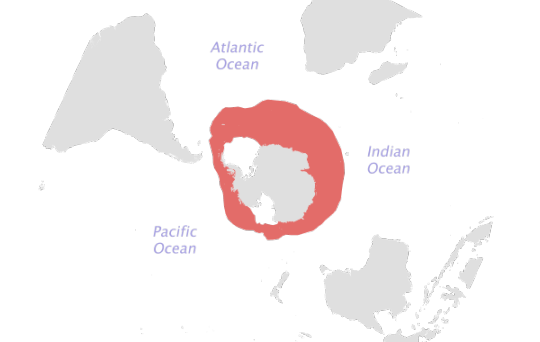
Figure 1. Geographical Distribution of Antarctic krill (fao.org, n,d,)
E. superba inhabits a wide circumpolar belt between the Antarctic Continental Shelf break and the Antarctic Polar Frontal Zone. Antarctic krill live in open marine waters (fao.org, n.d.). The larvae of the krill begin near the seafloor and gradually ascend towards the surface as it develops. Adult krills are found at depths ranging from surface waters to depths of 350 m and have occasionally been found as deep as 600 m. They usually dwell in deeper waters during the winter season (Gierak, n.d.).
Anatomy

Figure 2. External Anatomy of Antarctic Krill
E. superba known as Antarctic krills are shrimp-like in appearance though they can easily be distinguished from shrimp by their visible gills. Just like any other decapods they have exoskeleton which are made of chitin and have three body parts which is the cephalothorax, pleon and the telson. The cephalothorax bears the antennae, compound eye, 6 filter legs which are also called thoracopods and the gills. Krills have compound eyes which aid them in seeing while their antennae serve as another sensory organ as they live in the deep. The thoracopods or the filter legs on the other hand, assists the krill in straining its food from the water. Although the gills, guts and gastric mill are not part of its external anatomy, the three are visible from the outside. The middle part of its body is the pleon where the pleopods and the photophores are located. There are 5 pairs of pleopods or swimming legs that allow them to swim in the water column while the photophores or light organs act as a defense mechanism or a signal for their mates. Lastly, is the telson which is used by decapods as a paddle in caridoid escape reactions through backward propulsion (Grzimek's Student Animal Life Resource, n.d.).
Life Cycle
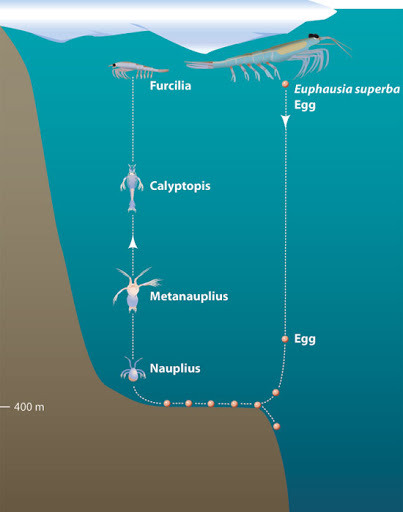
Figure 3. Life Cycle of an Antarctic Krills
Krills reproduce sexually and it usually happens when food is abundant. The male krill produces sperm packets and uses its first pair of pleopods called petasma to transfer the sperm into the thelycum of the female. They store the sperm until they are ready to lay their eggs. These eggs are fertilized once they are released by the female. These eggs settle at the seafloor and gastrulation happens. Eventually, the eggs will hatch and become a nauplius. In this the nauplius has only one eye and is not segmented yet. Then, the nauplius will molt and become a metanauplius wherein limb development begins and it will start to migrate to the surface which is known as developmental ascent. As it molts and grows, it becomes a calyptopis and eventually a furcilia wherein the movable compound eyes start to project at the edge of its carapace. The furcilia develops into a juvenile which can grow from 4 to 10 mm long (Gierak, 2013).
Ecology

Figure 4. Thoracic endopodite of krill (wikipedia.org, n.d.)
Antarctic krill are filter-feeders that feed mainly on phytoplankton. They exhibit diurnal vertical migration, which means that they rise to the surface at night to feed by using their small, hair-like legs specifically thoracic endopodites as a suspension feeding basket. Apart from phytoplankton, they also eat copepods, zooplankton, and other krill or molted exoskeletons. In the winter, they eat algae under the surface of sea ice. They are considered the dominant herbivore of the Southern Ocean. Its biomass in the Antarctic Ocean is estimated to be between 125 mmt and 750 mmt, the largest biomass of any species on earth (Hardy, 2008). Antarctic krill is the keystone species of the entire Antarctic food chain. They provide a vital food source for whales, seals, squids, penguins, fishes, albatrosses, and many other species of birds. To avoid predation, they exhibit schooling behavior or swarming. Moreover, krill may be parasitized by organisms like protozoans, particularly the genus Ephelota. This suctorian ciliates interacting with E. superba cause hydrodynamic drag on krill swimming and make the host more vulnerable to visual predators (Gómez-Gutiérrez & Morales-Ávila, 2016). Other parasitic species include Cephaloidophora pacifica and Apostoma sp.
UNLI-KRILL @ 199!
youtube
Krill’s POV
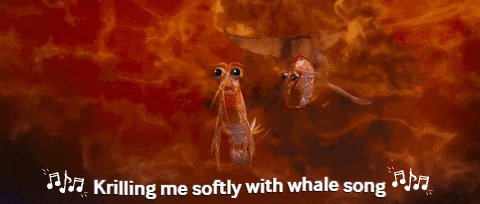
Relationship with humans
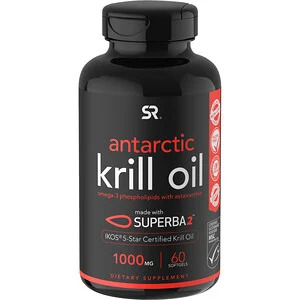
Figure 5. Sports Research’s Antarctic Krill Oil with SUPERBA 2 (ph.iherb.com, n.d.)

Figure 6. Krill/shrimp chili paste and dipping assortments in Thailand (quora.com, 2016)
Although krill is mainly used as aquaculture feed and bait for fishing, it is also processed into a variety of products for human consumption such as paste, frozen tails, sticks, etc. Krill products have been known to pharmaceutical and industrial industries since it is found that the krill's lipid content can be used as a nutritional source of fatty acids that is potential in lowering cholesterol levels. Studies found that the lipids of Antarctic krill are more stable than those of some fishes consumed by humans. Krill digestive proteases can also be injected into humans to reduce pressure on nerve roots between vertebral discs (Gierak, n.d.). Tou et al. describe Antarctic krill as a “rich source of high-quality protein” with low fat and high levels of Omega-3s and antioxidants and the main source of the renowned krill oil.
5 health benefits of Krill oil you shouldn’t miss!
youtube
Little did you know that..
They are age-defying!
*jaw-dropping moment because olay age-defying serum just cant--*
➔ They have the ability to shrink in size when starve to conserve energy during the winter. Thus, scientists can’t tell the age of a krill solely from its size.

Phytoplankton is just a summer fling!
➔ They can survive more than 200 days without food.
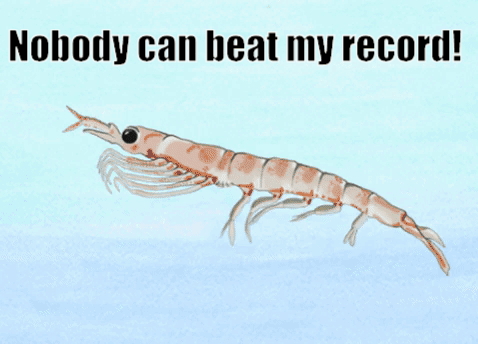
Krillions of krills!
➔ Krill swarm together in massive numbers, with as many as 30,000 in one cubic meter of a krill swarm.
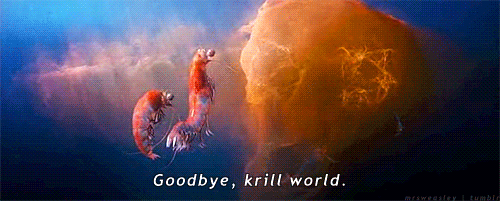
A Little Giant!
➔ It’s estimated that the total weight of Antarctic krill is more than the weight of all humans on Earth (Usoceangov, 2015).

Food is life but swimming is lifer!
➔ They are heavier than seawater and must swim constantly to stay afloat.
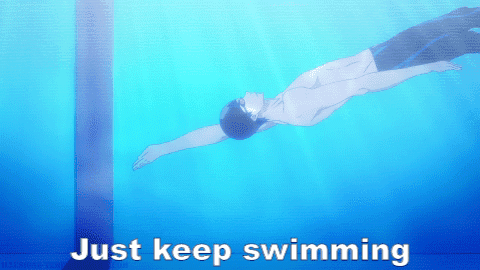
Climate heroes!
➔ Tarling and Thorpe (2017) have discovered that krill play a crucial role in sequestering carbon.
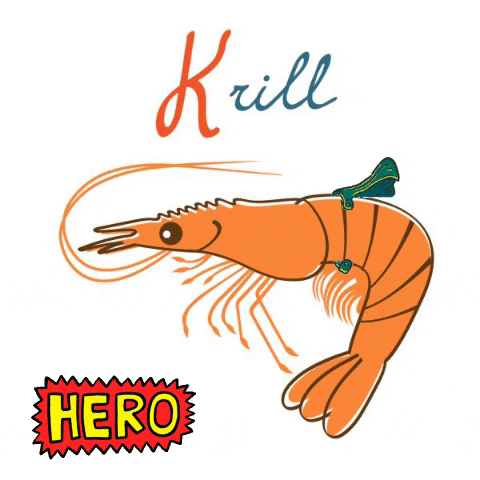
References:
Clark, D. (2012, September 17). The anatomy of the Arctic krill [Digital image]. Retrieved November 12, 2020, from http://1.bp.blogspot.com/-7NY88MHBVpc/UFfn-sAknuI/AAAAAAAAAW4/nkt1_Ba8G8k/s1600/Antarctic_krill_anatomy.jpg
Euphausia superba. (n.d.). ITIS. Retrieved November 8, 2020, from https://www.itis.gov/servlet/SingleRpt/SingleRpt?search_topic=TSN&search_value=95514#null
Euphausia superba (Dana, 1852). (n.d.). FAO. Retrieved November 10, 2020, from http://www.fao.org/fishery/species/3393/en
Exuvia of Antarctic krill [Online image]. (2005). English Wikipedia. https://commons.wikimedia.org/wiki/File:Exuviakrillkils.jpg
Gierak, R. (2013). Euphausia superba (Antarctic krill). Retrieved November 12, 2020, from https://animaldiversity.org/accounts/Euphausia_superba/
Gómez-Gutiérrez, J., & Morales-Ávila, J. R. (2016). Parasites and Diseases. Biology and Ecology of Antarctic Krill, 351–386. https://doi.org/10.1007/978-3-319-29279-3_10
Grzimek's Animal Life Encyclopedia. (2020). Krill: Euphausiacea. Retrieved November 12, 2020, from https://www.encyclopedia.com/science/encyclopedias-almanacs-transcripts-and-maps/krill-euphausiacea
Hardy, R. W. (2008). Alternative marine sources of fish feed and farmed fish quality. Improving Farmed Fish Quality and Safety, 328–342. https://doi.org/10.1533/9781845694920.2.328
Naruturd_505. (n.d.). Hoshiumi Korai A Little Giant GIF [Online GIF]. https://tenor.com/view/hoshiumi-korai-alittle-giant-smile-haikyuu-anime-gif-17909731
Oh, yeah- what?! GIF. (2013). Gfycat. https://gfycat.com/detailedfaintalbertosaurus
SuperSmiles17. (2013). Definitely one in a Krillion! [Online GIF]. https://imgur.com/gallery/YtN30/comment/16282449
Tarling, G.A., and Thorpe, S.E. (2017). Oceanic swarms of Antarctic krill perform satiation sinking. Proc. R. Soc. B., 28420172015. http://doi.org/10.1098/rspb.2017.2015
The Ozone Hole. (n.d.). [Life Cycle of Antarctic Krill]. Retrieved November 12, 2020, from http://www.theozonehole.org/images/v43n2-wiebe3en_10243.jpg
[Untitled image of a tardigrade]. (2017). BBC. https://www.bbc.com/news/science-environment-40752669
Usoceangov. (2015). Animals of the Ice - Antarctic Krill. Youtube. Retrieved November 10, 2020, from https://www.youtube.com/watch?v=RFqhocQqbgM
15 notes
·
View notes
Text
The Importance of Eco-friendly Products
The very word Eco-friendly brings lots of things in our minds; the most prominent thing would be Non-plastic and recycled. A broadway, eco-friendly defines our culture, the thought of being conservative in our needs, the thought of avoiding anything plastic. The culture which we have inherited from our elders.
We are in a fast-paced era where takeaways are the new normal, surgeries are quick and one can walk off a hospital the same day, Marriage events have clean dining halls but the plastics and non- bio-degradable we leave behind has never been thought.
The discovery of PVC was a key event in the history of mankind. PVC has given way for tubes, forms of vessels which we have never imagined that could be possible, the ease of mass production of bottles and other retail which occupy our homes.

This is a moment where one needs to pause and look back at the number of plastics we have ditched in rivers, oceans and also the number of trees which have been felled to make that furniture and daily useable like boxes and pencils.
The concept of reducing, recycle and reuse has caught up in the developing world as well as the advanced nations. Recycling those products which depend on trees to be cut for new materials is of the importance now. The reason for saying this is broad again. Where one can avoid deforestation and promote afforestation, we should as we have already amidst global warming which itself is going to take us to the brink of extinction.
Reports of ocean temperature rising by a degree and a half has already wiped out many marine species to extinction, besides changing the weather which we see on land due to El-Nino and La-Nina effects. The warming seas and the effect it has on the land has been well documented to show much large scale destruction to the land dwelling animals and plants apart from humans and our creations.
Tree covers in the safest guarded forest reserves are also facing the threat of deforestation by illegal activities and corrupt government policies. Fast-paced industrialization and real estate expansion is creeping into the green cover of reserve forests. This industrialization, although necessary needs to be regulated and that’s a slow process.
As humans, our needs are growing day by day, starting from tyres to plywood for construction. We depend on nature for our needs. However, with very little being done to replant the trees as we use them. A forestation is a key to bring back the balance between what we use by cutting trees and replant the land to make up.
Having covered the issues we are facing today in terms of depleting green cover and disposal of used plastics into oceans, the only thing in our hands as an individual is to be responsible for our choices when we buy products.
Multiple products are now emerging in the markets which are bio-degradable and eco-friendly. The core idea behind eco-friendly here is to ensure that as much as possible, use of recycled paper and paper products to substitute the products which depend on the felling of trees.

Products like pencils which are made from recycled newspapers have more strength compared to the ones made from wood and mass-produced. Even in the case of recycled and eco-friendly pencils, one can always choose the darkness of the lead and thickness of the lead, or even colors. The point is, one need not sacrifice anything when they switch over to eco-friendly products.
Similarly, A4 sheets which we use for printing in offices, Eco-friendly products are replacing the latter with the same quality, thickness and without any blemishes as one would expect.
Paper cups and food packaging is now being made out of recycled paper. The quality of the process related to manufacturing has improved to reduce the smell which we all have noticed with recycled paper products; the strength and integrity of the packaging material have also been improved to adhere to strict industry standards. Eco-friendly paper cups and food packaging again reduce the use of new paper hence helping the environment.
This can also be taken up as a corporate responsibility where the management can shift to eco-friendly products. The cost factor variance between a regular reel of A4 sheets in the market and an Eco-friendly – recycled paper for printing is almost negligible.
These are the small changes that one can do to minimize our footprint. We as humans have the responsibility to protect the only earth we have for our future, for future belongs not to us but our children.
1 note
·
View note
Photo

Cambodia’s endangered river dolphins at highest population in 20 years
Stefan Lovgren - April 5, 2019
It’s 5:30 p.m., and several tourist boats linger in the middle of the Mekong River. A blood-orange sun casts a warm glow across the milky brown water, making it the ideal time to photograph the rare Irrawaddy river dolphins that congregate in deep, swirling pools. Not that these dolphins are particularly willing photo subjects, as the tourists on this day are finding out.
While marine dolphins often jump fully out of the water while swimming on a continuous path, the snub-nosed—and indisputably adorable—Irrawaddy dolphins, which grow to be up to eight feet long, will only partially breach the surface before diving back below. They may briefly pop up in one place only to reappear the next time in a random spot a few hundred feet away. The clicking of tourist cameras following each glimpse inevitably comes too late.
It’s an impressive disappearing act. Yet the most remarkable feat these dolphins have pulled off may be that they have not disappeared.
For decades, Cambodia’s Mekong River population of Irawaddy dolphins has verged on extinction. Once believed to have numbered in the thousands, the population began to plummet in the 1970s. During the violent reign of the Khmer Rouge and the years of war that followed, the dolphins were hunted for food. Indiscriminate net fishing, in which the dolphins sometimes end up as bycatch, took a further toll, and by the turn of the millennium, there were maybe fewer than 100 left.
Some conservation measures were finally implemented in the mid-2000s when the World Wildlife Fund (WWF) partnered with the Cambodian government to support law enforcement efforts combating unsustainable fishing practices, which include using poisons and dynamite. Around this time, the Cambodian government also began promoting the dolphins as a flagship species and tourist attraction. Yet it takes time to crack down on illegal activity, and in 2015, a population census showed only 80 individuals remaining.
Then, last year, came some good news. A new survey found 92 dolphins in the Mekong River, the highest number in more than 20 years. Researchers identified nine newborn calves. This year, three more have already been found. Eng Chea San, the director general of the Cambodian Fisheries Administration, says there may be a dozen or more previously unidentified dolphins living in the river.
No one is celebrating just yet, though. The dolphin population remains well below what is considered safe to ensure its future survival. A wide array of threats persists, most notably the planned construction of a new 2,600-megawatt dam in Sambor, Cambodia, which would eat into core dolphin habitat. High mortality among young dolphins also continues to mystify scientists. (Read why Southeast Asia may be building too many dams too fast.)
But, says Mark Drew, a WWF program director in Cambodia, which has spearheaded the dolphin campaign, “We may have been able to bend the curve.” The WWF’s country director Teak Seng calls it “fabulous news,” but adds that there is no time for complacency. “As threats to their survival persist, we need to redouble our efforts to protect the dolphins both for their future and that of the river and communities that live alongside it,” he says.
Ecotourism Stars
Less famous than their ocean-dwelling cousins, river dolphins are among the most endangered creatures on Earth. In 2007, the Yangtze River dolphin, or bajji, became the first mammal to go extinct in more than 50 years and the first cetacean species ever driven to extinction by human activity, according to a Royal Society study.
The Irrawaddy dolphins, which, with their bulging foreheads resemble small beluga whales, live in brackish water near coasts, river mouths, and in estuaries in southern Asia. But three freshwater subpopulations have been established in three rivers, including the Mahakam River in Indonesia, the Ayeyarwady (or Irrawaddy) River in Myanmar, and the Mekong, which originates in the Tibetan highlands and runs through six Asian countries before emptying into the South China Sea. (Read about how “electro-fishing” in Myanmar puts river dolphins at risk.)
The Mekong population, believed to be the largest of the three, occurs here in northern Cambodia. It’s an area that, like most of Cambodia, has experienced intense fishing pressure for decades. The biggest problem for the dolphins has been entanglement in gill nets, causing them to drown.
In 2012, the Cambodian government declared the entire stretch of the river a protected zone, with fishing prohibited at all times in core dolphin habitat. Today, the rules are enforced by a contingent of 32 river guards, and officials say overall dolphin mortality has gone down significantly. “It is no doubt because of the conservation efforts that we are seeing more dolphins,” says Eam Sam Un, a biodiversity and monitoring manager for the WWF. (Read more: Can the Mekong river basin be saved?)
Greater involvement from local communities has also helped, conservationists say. Revered in both Cambodia and Laos, where many people believe the animals are reincarnations of their ancestors, the Irrawaddy dolphins have become a focus of Cambodia’s burgeoning ecotourism sector, which supports the conservation work.
The attention given to the dolphins also has positive spillover benefits for other wildlife in the ecologically troubled Mekong region, says Zeb Hogan, a fish biologist at the University of Nevada in Reno, who leads a USAID research project called Wonders of the Mekong. “The dolphin is a flagship species, it’s well known in the area, highly visible and attracts national and international conservation interest and funding,” he says. “The protection of dolphins helps to protect the habitat of other wildlife in the area, including endangered turtles and large-bodied fish.”
Dolphin Catalogue
Researchers still have much to learn about the behavior and ecology of the Irrawaddy dolphins, says Lindsay Porter, a dolphin expert who traveled to Cambodia and works with the Hong Kong-based Sea Mammal Research Unit connected to the UK’s University of St. Andrews.
“We don’t really know why the dolphins congregate in these pools, some of which can be 150 feet deep,” says Porter. “It could be because of the availability of food there or possibly because there is less disturbance.”
Researchers are trying to keep track of all individuals in the population, which is no easy task. The only way to differentiate between individuals is by their small dorsal fins, which have slightly different shapes. The fact that the animals only pop up for very short moments and don’t bring their bodies out of the water make them incredibly difficult to photograph for identification purposes.
“It means you’re going to spend a lot of hours on the water,” says Porter, who is involved in a project to update the detailed catalogue of individual dolphins that officials maintain. Porter and other researchers are also planning to study the dolphins’ sophisticated use of whistling as a means of communication.
Teak, the WWF director, is optimistic about the animals’ future. “The Irrawaddy dolphin is Cambodia’s living national treasures and key indicators of the health of the Mekong River,” he says. “Their recovery is a hopeful sign for the river and the millions of people who depend on it. After years of hard work, we finally have reason to believe that these iconic dolphins can be protected against extinction.”
8 notes
·
View notes
Photo

Atlantic Cod (Gadus morhua)
Family: Cod Family (Gadidae)
IUCN Conservation Status: Vulnerable
Native to the northern Atlantic Ocean, Atlantic Cods live in large shoals that may contain more than 10 million individuals, with larger, stronger individuals swimming ahead of their smaller travelling companions to determine the direction the shoal swims in and “scout” for predators such as Greenland Sharks and Orcas. Growing to be 68-130cm (27-51 inches) in length, adult Atlantic Cod are safe from all but the largest predators (particularly while in shoals) and may live for over 20 years. The diets of individuals of this species vary considerably depending on their size and maturity: large individuals (such as those that act as scouts) feed on moderately sized fish such as Atlantic Haddocks, Common Soles, Atlantic Mackerel and (on rare occasions) juveniles of their own species, while smaller individuals feed on smaller fish and marine invertebrates such as squids, bivalves, starfishes and sea cucumbers - regardless of size, food is mainly found using the single goatee-like barbel (a sensory organ that detects chemicals released into the water by prey) which protrudes from the front of the lower jaw. Many populations of Atlantic Cod are migratory and return to specific spawning grounds to reproduce each year; after arriving at a spawning ground, numerous males will circle around mature females while producing drum-like booming noises and fighting off smaller rivals in an attempt to impress the female, and upon successful courtship a female will produce clusters of several million tiny gelatinous eggs which will be fertilized externally by a male of her choice before being carried away to coastal environments by the tide. Most of these eggs will be eaten or otherwise die before they are able to hatch, but those that survive will hatch into tiny plankton-eating larvae which slowly grow into coast-dwelling juveniles before reaching maturity at around 2-4 years of age and travelling further from the coastline in search of a shoal to join. Atlantic Cods are regularly caught and eaten by humans, and while this has led to extremely concerning declines in the species’ population there is a potential for increased legal protection of wild Atlantic Cod (particularly those found at their spawning sites) and a higher reliance on farmed individuals for food (thus reducing the impact on wild populations) to give this species a chance to recover.
--------------------------------------------------------------------------
Animal Advent Calendar - Day 19
Image Source: https://www.inaturalist.org/taxa/63740-Gadus-morhua
#December 19th#Atlantic Cod#Cod#Cods#fish#fishes#zoology#biology#icthyology#animal#animals#wildlife#Atlantic wildlife#marine biology#marine wildlife#EXCELLENT LITTLE GUYS
78 notes
·
View notes
Photo










International Day Of The Seal
International Day of the Seal takes place on March 22. It is a day set aside to raise awareness about seal conservation around the world. It’s also a day for us seal lovers to honor this amazing sea mammal. Seals are not only adorable and attractive, but their presence in the world today has a significant impact. They are also the most targeted marine mammal on the planet. These creatures are in danger of soon becoming extinct. Humans have always posed a significant threat to them, as people capture them for feed, blubber, or pelts. As a result, this day is observed to emphasize the importance of preserving their population.
History of International Day Of The Seal
This international holiday was established in 1982. Since then, the holiday has been observed yearly on March 22. The total number of seal species was already declining at the time. Seals were increasingly becoming victims of humans. This is because humans hunted seals for their pelts, blubber, and meat. To put an end to this brutality, the day was proclaimed the “Day of the Seal.” The United States Congress established the worldwide holiday to raise awareness among Americans about the plight of seals. They developed several projects to raise awareness about the importance of protecting seals.
A seal is classified as a pinniped, which means “fin-footed” in Latin. The walrus and sea lion are two other pinnipeds. Seals are distinct from other pinnipeds in that they do not walk with their flippers. They frequently move about on their bellies when on land. Their flippers assist them to move quickly in the water. Seals are also calmer and smaller than sea lions and walruses.
Seals are located around the north and south poles. They are preyed upon by predators and hunters. This has put their population at risk. This day was established to raise awareness about how they might be saved.
This day is observed all over the world. Although seals dwell in the Arctic Circle and Antarctica, millions of people around the world adore them, and so this holiday is observed globally.
International Day Of The Seal timeline
1811 Pinnipedia
Johann Karl Wilhelm Illiger names both a clan and an order Pinnipedia.
1886 The Extinction of the Seal
The animal is considered extinct until a little group is discovered near the Yucatán Peninsula.
2001 The Link Between Sea Lions and Seals
Genetic analysis reveals that the north fur seal is more closely linked to many sea lion species.
2021 Recognition By the I.U.C.N.
Thirty-six pinniped species are recognized by the International Union for Conservation of Nature (I.U.C.N.).
International Day Of The Seal FAQs
Seals descended from what animal?
The earliest progenitors of seals and sea lions were mammals that evolved from land to sea. The ocean began to cool around 36 million years ago, near the end of the Oligocene, causing major changes in ocean circulation.
Is the seal a friendly creature?
Seals look attractive and sociable, which they are. Most zoos and marine attractions portray seals as trainable, clever, and human-friendly.
Do seals have fur?
Northern fur seals have the second thickest fur on the planet, with 300,000 hairs per square inch.
How to Observe International Day Of The Seal
Attend a public awareness event
Watch a documentary about seals
Visit a seal exhibit zoo
During International Day of the Seal, many naturalist organizations and zoos host awareness events. Attend a presentation to learn more about these wonderful creatures.
There are numerous videos and reading resources available about seals and their habitat. Spend the day learning about how climate change affects these seals.
Seals are related to sea lions and walruses, which live in the Arctic Circle and Antarctica. However, you don't have to travel to the poles to meet these magnificent creatures. To celebrate the festival, you can visit a zoo and learn about them.
5 Interesting Facts About Seals
There are various species
Their skin helps with temperature
They can detect prey
They live up to 30 years
They are heavier than us
There are 33 kinds of seals.
Blubber is the layer of fat beneath the skin of seals that keeps them warm in frigid water.
A seal’s whiskers aid in the detection of prey in murky water.
Their life expectancy is 25 to 30 years.
Smaller seals weigh 100 pounds, while the largest weigh more than 7,000 pounds.
Why International Day Of The Seal is Important
It’s a week to achieve something worthwhile
It encourages study
It encourages conservation
All animals are important. International Day of the Seal allows us to perform important conservation work and identify solutions to help the planet.
International Day of the Seal encourages people to learn more about seals. It is a means of making people more aware of their place in the larger scheme of things.
The importance of conservation of vulnerable animals is emphasized on this day. Contributions to this cause are encouraged.
Source
#Point Arena#Monterey#Elephant Seals of San Simeon#habor seal#USA#summer 2022#2017#Northern elephant seal#Pacific Ocean#fauna#animal#Elephant Seal Vista Point#wildlife#International Day Of The Seal#22 March#InternationalDayOfTheSeal#InternationalSealDay#California#West Coast#original photography#tourist attraction#flora#landmark#nature#beach
1 note
·
View note
Link
When an animal senses danger, it might freeze to try to avoid being seen. Or it might flee, to try to get away. But when narwhals encounter people, they do a bit of both, a new study finds.
After escaping from a net, these whales dove deep underwater. That part of their reaction looked like fleeing. At the same time, their heart rates and breathing slowed, as if they were trying to hide.
It’s an unusual combo. Normally the heart races during intense physical activity. That helps pump more blood, oxygen and nutrients to working muscles. And the narwhals’ escape dives definitely qualify as intense activity. During those dives, they pump their tails at rates of up to 25 strokes per minute. So this drop in heart rate was surprising — especially as it was so dramatic.
Indeed, says Terrie Williams, “That was astounding to us.” As an ecophysiologist (EE-koh-fih-zee-OL-oh-gizt) at the University of California, Santa Cruz, she studies how animals’ body functions affect how they interact with their environment. “There are other marine mammals that can have heart rates that low, but not typically for that long a period of time. And especially not while they’re swimming as hard as they can.”
Narwhals are well-adapted to diving. Their main food is deep-dwelling ocean fish. During their main feeding season, these whales can dive 800 to 1,500 meters (2,400 to 4,500 feet) below the Arctic sea ice for 25 minutes at a time. But like other mammals, they need to breathe air. To conserve oxygen while foraging for food, they can slow their body functions. The normal heart rate for a narwhal is about 60 beats per minute. That’s similar to what’s seen in people. But during a long underwater feeding session, a narwhal can drop its heart rate to just 10 or 20 beats per minute.
Explainer: What is a whale?
To evade natural predators such as killer whales, narwhals don’t usually dive away. Instead, they tend to hide. They may sneak under ice sheets or huddle in spots too shallow for their pursuers, Williams notes.
But in response to people, they react very differently. “When narwhals detect humans, they often dive quickly and disappear from sight,” observes Kristin Laidre. She is an ecologist at the University of Washington in Seattle. Although she studies Arctic narwhals, she did not take part in this study.
Williams worked with research colleagues from Denmark. During these escape dives, they wanted to know what happens to the whales’ bodies. To do this, they partnered with indigenous hunters in East Greenland. The hunters knew how to capture narwhals in nets. The researchers used suction cups to stick monitoring equipment to the narwhals’ backs. After releasing the creatures, this team tracked tail strokes and heart rates in the whales. They used these data to calculate how much energy the narwhals used during their deep escape dives.
Dives to feed were different from those that came after being entangled in a net for an hour or more. During escape dives, Williams explains, “the heart rates were going down to levels of three and four beats per minute!” And they stayed “at that level for 10 minutes at a time.”
Her team observed the narwhals making multiple dives in the hours following their escapes. And they dove deeply — 45 to 473 meters (about 150 to 1,500 feet) down. Such dives burned about twice as much energy as normal feeding dives. Those post-escape dives burned up three to six times more energy than when the animals were at rest.
Frantic getaways, combined with super-low heart rates, take a steep toll. Escape dives gobbled up 97 percent of the available oxygen in the narwhals’ lungs, blood and muscles, the authors calculated. That’s almost twice the 52 percent used up during normal dives of similar depth and duration.
So far, Williams says, these costly escapes have been observed only after a prolonged interaction with people. It’s not yet known whether such an extreme physical response could weaken the animals over time.
The international team of researchers shared its findings December 8, 2017 in Science.
This new study highlights how the behavior of these whales makes them especially vulnerable to interactions with people, Laidre says. And, she adds, such human contact is “likely to increase in the Arctic with sea ice loss.” Less ice means more boats and more encounters with people. Seismic exploration, hunting and noise from large vessels and fishing boats also can disturb wildlife. Today, narwhals already are a species that is nearly threatened with extinction. So conservation efforts must account for human impacts, Laidre says.
Williams’ group plans to investigate whether narwhals show the same flee-and-freeze reaction to other disruptions. They also want to track any long-term health effects of such extreme escapes.
“There is a concern from our group that this is just pushing the biology of these animals beyond what they can do,” Williams says.
18 notes
·
View notes
Text
An excerpt from the zoological text The Hunter’s Encyclopedia of Animals (First Edition).
Chapter VI: Plesioth
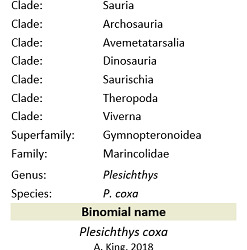
The plesioth (Plesichthys coxa) is a species of pelagic wyvern found off intertropic coasts across the globe. At a weight of 4.7 tons and a length averaging 26 meters, it contends for the title of largest marine predator. The plesioth’s physiology is adapted to a life spent transitioning between land and water — it is capable of diving to depths of 450 meters at speeds of 54 km/h (34 mph), and remaining submerged for 40 minutes at a time. The plesioth’s ability to fly was forfeited early in its evolutionary history, replaced by adaptations that allow it to withstand extreme deep-sea pressure and low concentrations of dissolved O2. Its vestigial wings, meanwhile, underwent exaptation and have been jury-rigged into fin-like appendages that assist in swimming. According to one study, the plesioth’s lifespan is approximately 50 years.
The plesioth has few natural predators as a result of its venomous spines. Laterally-visible, horizontal orange stripes advertise the neurotoxin to any potential predators. Every so often, juveniles are susceptible to predation by sympatric predatory megafauna. In addition to its aposematic coloration, the plesioth can ward off predators by forcefully ejecting a fluid from a pair of glandular sacs inside its mouth. This liquid projectile can be accurately sprayed as far as 5 meters (16 feet). The fluid is miscible in water, and therefore exclusively used on land. Both of the aforementioned adaptations are utilized as antipredator mechanisms and have no function in hunting. Rather, the plesioth is an ambush predator that kills its prey through a combination of stunning (tail-slaps, high-velocity breaches) and drowning. Countershading obliterates its outline in the water, with its dark dorsal scales making it inconspicuous to animals looking down on it from above. The bulk of its diet is comprised of fish, and as the plesioth matures it begins to incorporate larger prey species such as pinnipeds, pseudophids, and ornithischians. Because of the plesioth’s moderate fecundity and wide distribution, its conservation status is classified as least concern.
The plesioth has a recurring presence in the cultures of seafaring people. Although it doesn’t actively hunt humans or wyverians, plesioths have been known to follow ships at a distance. They scavenge on bycatch and waste jettisoned from vessels, and occasionally raid nets and fishing lines for an easy meal. As a consequence of conditioning them to associate boats with food, plesioths are the most likely culprits of attacks on shipwreck victims. Their ghostly white, translucent third eyelids, in conjunction with their habit of congregating near sunken ships, may have influenced the myth of plesioths being psychopomps. A number of equatorial communities honor the plesioth through week-long ceremonies and parties. Such festivals are accompanied by the custom of mounting a plesioth’s skull or severed head on an ornately-carved pole, not unlike a Mari Lwyd. Anthropologists speculate that a misunderstanding led to the belief that the mounted head was actually a hammer. Traditional dishes include a ceviche marinated in citrus, and rotten flesh fermented in lactic acid. In medicine, the plesioth’s venom has potential as an anesthetic and a pharmaceutical drug for treating insomnia.
Other names for the plesioth include the plesio, water wyvern, and shark wyvern. The latter is a title it shares with the cephadrome (Selacharena alata) and anorupatisu (Pristocephale glaciesecans).
The plesioth’s name is an example of semantic drift. The word is originally derived from the clade Plesiosauroidea, a group of long-necked marine reptiles. Plesiosaurus is a compound of the Greek words plēsíon “near” and saûros “lizard,” and refers to the group’s resemblance to limbed squamates. Over time, the prefix plesio- was recontextualized to have the meaning “like or similar to a plesiosaur.” Thus, the plesioth was named for its resemblance to plesiosaurs, and was assigned the suffix -ioth to maintain the naming convention already established in the common names of other animals (like the lavasioth and epioth). Ironically, the genus Plesichthys is a portmanteau of plēsíon and ikhthús “fish,” and was named for the plesioth’s near fish-like appearance.
Taxonomy and evolution
Fossil evidence suggests that the plesioth evolved from a unique lineage of diving wyverns 10 million years ago. Unlike other vivernans of that period, the plesioth’s ancestor Marincola marincola [†] was semiaquatic, roosting in small colonies on seaside bluffs. Its streamlined body reduced drag when plunging from flight, allowing it to hit the water at breakneck speeds exceeding 80 km/h (50 mph). Air sacs in the face and chest cushioned the impact, a feature which was later lost in its descendant (along with skeletal pneumaticity). The ancestral plesioth moved underwater via foot propulsion, with the wings used for steering. Today P. coxa primarily swims using a combination of its webbed feet and an undulatory locomotion reminiscent of BCF (body-caudal fin) swimming. A comparison of the foot morphology between the holotype M. marincola and modern gannets supports the diving → swimming transition theory, and proposes a convergence amongst semiaquatic theropods.
While the plesioth shares a common ancestor with flying wyverns, it has a long history of genetic independence from its closest relatives (raths, khezus, and other vivernans). Molecular systemic DNA research places the plesioth in a basal lineage of gymnopteronoid.
Subspecies
There are only 2 extant representatives of the family Marincolidae. Each subspecies is characterized by scale coloration, distribution, circadian rhythms, and preference for hunting techniques.
The oil-backed plesioth, or informally simplified to oil-back (P. c. coxa), is the nominate subspecies. Its range encompasses the subtropic and tropic coastlines of the West Dragon and East Dragon Oceans, and the interior seas of South Elde: Jyuwadore, Shikuse, and Moga. It inhabits seagrass meadows, kelp forests, coral reefs, and coastal alcoves which have a water temperature between 13°C and 29 °C (56°F and 85°F). Although P. c. coxa is active during the day it is primarily a crepuscular predator, and has greater success at hunting during the hours of dusk and dawn. It gets its name from the appearance of its dark blue scales when seen in clear water with low turbidity; the contrast gives it a resemblance to “an oil spill come to life.”
The green plesioth (P. c. viridis), unlike P. c. coxa, dwells in brackish ecosystems, including wetlands, swamps, and estuaries. They typically avoid venturing out into saltwater, although fishermen have reported seeing them as far as a mile from the nearest coast. It’s generally accepted that the presence of green plesioths in mangrove swamps (near Jumbo Village) and river mouths (like those of the Metape Jungle and Flooded Forest) reduces competition with the oil-back. P. c. viridus takes advantage of its green pigmentation by concealing itself amongst hydrophytic plants such as water lettuce and duckweed. Perhaps because of its greater reliance on camouflage, this diurnal subspecies almost never breaches when hunting.
Characteristics
Physical description
As a member of the clade Viverna, the plesioth’s body plan is largely representative of the wyvern archetype: a bipedal stance and horizontal posture with the tail held parallel to the ground. Where the skeletal structure differs is in the wings. While the thumb in other wyverns is short and supports the leading edge of the wing, all of the plesioth’s metacarpals and phalanges are elongated and involved in supporting the membrane. The pleated patagium can be tucked against the plesioth’s torso while swimming, thereby reducing surface area and contributing to its streamline, hydrodynamic shape. The wings range in color from white to cream, with orange spots on the outer edge of the dactylo- and iliopatagium. The backside of the torso and head are deep blue, while the underbelly features white scales. The ventral and dorsal regions are sharply delineated by lateral orange stripes that run from the conical snout to the tail along the frontal/coronal plane. Imbricate, ovate scales flow down the body in a head-to-tail configuration that allows for a smoother flow of water over the body to reduce drag. Their visual and functional similarity to cycloid scales on teleosts is homoplastic. The feet are totipalmate.
The plesioth partly owes its charismatic appearance to its white red-tipped semifins. The semifins are webbed structures supported by cartilaginous spines, attached to an endoskeletal base with associated muscles for movement. Being cartilaginous makes the semifins flexible and allows them to flare or collapse against the body. They are classified according to location on the body: dorsal, supercaudal, subcaudal, cranial, tarsal, and pseudopercular. The semifins’ spines are the site of venom conduction.
When submerged, the palatal valve at the back of the mouth creates a watertight seal which barricades the esophagus and trachea. This enables the plesioth to seize prey underwater without drowning, although it has to return to land in order to eat. When hunting, its cone-shaped, slightly recurved teeth allow it to tear through small and medium-sized fish. The carinae (edges of the teeth) are finely-serrated with denticles on the front and back, suited for biting prey outside of an exclusively piscivorous diet. The dentary and premaxilla/maxilla hold 36 teeth that are more densely-packed toward the front of the jaw, and that decrease in size toward the back of the mouth. During attacks, the nictitating membrane is drawn across the eye to protect it from abrasions.
The loss of tyrosinase function results in a genetic mutation called amelanism. Colloquially known as seabream plesioths (after fish in the genus Pagellus), individuals with this pigmentation abnormality don’t produce melanin and have white in lieu of their typical aegean coloration. Because the mutation only disrupts melanocytes, the chromatophores responsible for their orange and iridescent properties — erythrophores and iridophores — are still expressed. The continued production of light-reflecting and carotenoid pigments is what gives the seabream plesioth is distinctive white and reddish-orange look.
Venom
In total, the plesioth has 31 spines distributed across its body. They form part of the semifin, which occurs either in symmetric pairs, or along the medial region of the body. Although the semifins are superficially reminiscent of the ray-fins found in actinopterygians, they aren’t homologous. Semifins are classified into 6 categories according to body region, with the following spine distribution: 4 cranial, 8 pesudopercular, 7 dorsal, 4 tarsal, 4 subcaudal, and 4 supercaudal. The largest spines measure at 7’ 4” (2.2 meters) and are more than capable of penetrating the skin of the largest marine animals.
The primary structural element of the spines is cartilage, a supple and elastic tissue comprised of a dense network of collagen fibers embedded in a gelatinous ground substance. Its composition gives the spines tensile strength, enabling them to resist changes in weight and pressure while possessing greater flexibility than bone. Because cartilage is an aneural, avascular tissue, spines cannot be regrown if they’re damaged or removed. A protective integumentary sheath obstructs the opening of the spine. During envenomation, the sheath is pushed back as it enters the attacker. This process compresses the venom gland at the base of the spine, and allows the venom to diffuse into the puncture wound by travelling through shallow grooves in the now-exposed spine.
It’s thought that the semifins originally evolved as accessories for swimming, and that venom acquisition was a supplementary feature. The plesioth’s venom glands produce a subgroup of neurotoxins known as hypnotoxins, a soporific venom that depresses the central nervous system and affects the neurotransmitter gamma-aminobutyric acid (GABA) at the GABAA receptor. Its symptoms are much like the effects of anesthesia, and can be divided into the same 4 stages of the Guedel’s classification: induction, excitement, subconsciousness, and overdose. At Stage 1, the victim progresses from analgesia without amnesia to analgesia with amnesia. It’s entirely possible that the lack of pain — coupled with memory impairment — can lead to the victim’s inability to recall the initial sting and recognize that they are in danger. Stage 2, arguably the most dangerous, is when life-threatening conditions occur, such as delirium, arrhythmia, vomiting, respiratory distress, pupillary dilation, and spastic movements. Species that lack gills can quickly become disoriented after envenomation and drown as a consequence of the respiratory system becoming compromised (through pulmonary aspiration, apnea, et cetera). Stage 3 is the cessation of the previous symptoms and the onset of subconsciousness. Branchial predators become incapable of pursuing the plesioth, while air-breathing predators at this stage are all but 100% guaranteed to drown. Stage 4 is incredibly rare, and usually occurs if the spines puncture the victim for a long enough duration, or if multiple spines are involved in envenomation. Overdose results in brainstem or medullary depression, followed by complete respiratory and cardiovascular arrest. Without medical intervention this stage is always fatal.
Additional health risks posed by envenomation include: pieces of the spine breaking off and embedding themselves in the wound, leading to infection; and anaphylactic reactions to the venom.
Water-spitting
Before the plesioth’s phylogeny was properly understood, a common misconception was that P. coxa had gills and was descended from an unknown clade of branchial tetrapods. Its ability to spit a high-pressure jet of water from its mouth was likened to various species of archerfish. Later studies proved that the plesioth is a theropod, which made the archerfish’s mode of liquid projectile an impossibility as it involves contracting the opercula (gill covers). Dissection and field observations led to the discovery of paired sacs at the back of the mouth. Dubbed the paralingual glands, these poorly-understood organs can expel up to a quart (32 ounces) of liquid at once and possess just enough of the chemical for 10 discharges (2.5 gallons’ worth), before the glands have to produce a new supply over the next fortnight. The expulsion release is controlled by muscles behind the jaws. There is insufficient data as to what the liquid is composed of, but preliminary chemical analysis suggests a high presence of hydrogen and oxygen.
Diving adaptations
Even though the plesioth is most frequently observed inhabiting the photic layer (the uppermost layer of the pelagic zone, 0 m — 200 m), it can also be found within the mesopelagic layer (200 m — 450 m). At these depths, pressure can be greater than 40 times that of the surface. A combination of stressful deep-sea conditions such as high pressure and low oxygen can cause mechanical barotrauma. To eliminate the risks of physical damage like decompression sickness and organ rupture, the plesioth’s bones became depneumatized. The loss of postcranial air-sacs in the skeleton makes the plesioth denser and prevents embolisms (from buildups of dissolved N2) by decreasing the total air volume in the body. Similarly, the presence of air-filled pockets in the skeleton would have increased buoyancy, a trait that would have been disadvantageous to a diving animal.
Enhanced anaerobic capacity and hypoxemic tolerance are essential for facilitating long dives. When submerged at certain depths, the heart rate is reduced to as low as 20 — 30 bpm. Bradycardia occurs when the plesioth exceeds its aerobic dive limit (ADL), at which point tissue perfusion and oxygen uptake are decreased in order to preserve respiratory and blood oxygen stores. Non-essential organs are shut down and muscles are isolated from circulation, which together cut down on oxygen depletion and extend dives for as long as 40 minutes. Hemoglobin in plesioths shows high cooperativity with oxygen, a phenomenon whereby the binding of one molecule of oxygen with hemoglobin facilitates the binding of the next oxygen molecule and so on up to binding four oxygen molecules by one hemoglobin. The degree of cooperativity hemoglobin has is expressed by the Hill coefficient, which is estimated to be well above 4 in P. coxa. High cooperativity increases the efficiency of the oxygen delivery to tissues. Without these traits, the plesioth wouldn’t be able to withstand the extreme demands placed on its respiratory and circulatory systems that would otherwise result in unconsciousness.
To compensate for diminished olfaction and the mesopelagic layer’s low visibility, the plesioth has evolved powerful visual acuity. Its emmetropic eyes possess a flattened cornea that makes the cornea’s refractive power in air and the corneal power loss in water negligible. Roughly 10% of the eyes’ refractive power is contributed by the cornea, unlike in humans, which contribute up to 70%. Instead, the lens performs the majority of the focusing. This feature minimizes the optical effect of submergence. Sharp images above and underwater are formed by plesioths changing the shape of the lens through muscle contractions.
Behavior
Intraspecific interactions
Plesioths do not routinely seek out conspecifics outside of the breeding season. When plesioths do encounter others in the water they tend to ignore each other, though they demonstrate a remarkably high tolerance for each other’s presence. Socialization isn’t unheard of, however; plesioths may engage in cooperative hunting behavior if two or more are pursuing the same target. Juveniles and subadults will sometimes swim in small bands of three as an added precaution against predators.
Hunting and diet
The plesioth is a predominantly piscivorous animal, with 60% of its diet featuring a large diversity of fish species that are obligate shoalers. Despite this, they are not fastidious in their food choice and readily vary their prey selection according to availability, as evidenced by the remains of other animals found in their stomachs and fecal matter. Juveniles are restricted to hunting fish and other small vertebrates, and only begin to diversify their diet around the age of three. Mature adults are slightly more opportunistic, having the required size to take on larger non-fish prey items. A 30-kilo (66 lbs) meal can sustain a plesioth for up to 5 to 9 days before it is required to hunt again. Scavenging on carcasses isn’t overly common, nor is venturing inland to hunt. Plesioths only go after terrestrial prey when it’s near the water’s edge and within striking range. There are three generally-accepted hunting tactics employed by plesioths, with a slight skewing of preference between the subspecies: ambush-drowning, breaching, and tail-slapping.
The preferred method of taking down non-aquatic animals involves the plesioth motionlessly dwelling along the waterfront. The blue (P. c. coxa) and green (P. c. viridis) dorsal coloration is cryptic for each subspecies’ respective habitat. Concealment allows the plesioth to remain undetected long enough for it to ambush prey. Its conical, recurved teeth are suited for preventing prey from escaping once it seizes them in its jaws. The blinding speed with which it strikes gives the plesioth enough time to drag its prey into deeper water, where it then holds it beneath the surface until it succumbs to a combination of exhaustion, blood loss, and oxygen deprivation.
Breaching is a tactic reserved for animals such as epioths, ludroths, and seals, and is almost exclusively seen in P. c. coxa. The oil-back slams into prey from the deeper water below, with the momentum often taking it partially or fully clear of the water (achieving a max height of 10 meters). At speeds of 54 km/h, the g-force behind the impact is sufficient enough to fully stun prey.
The final hunting strategy is a tail-slap deployed either overhead or sideways. A kinematic study of plesioths attacking bait balls found that the tail-slap occurred with such force that it caused dissolved gas to diffuse out of the water column, forming small bubbles. Due to acceleration of waterflow around the leading edge of the tail, turbulent pressure drops below the saturated vapor pressure, causing the aforementioned plume of bubbles. The associated shockwave is powerful enough to immobilize as many as 20 fish in one tail-slap, which cuts down on the energy costs of hunting active prey.
The diet of P. c. coxa includes a wide array of aggregating fish such as pin tuna, speartuna, glutton tuna, Moga tuna (Katsuwonus katsuo), knife mackerels, wanchovies, sardines, and blue cutthroats. Oil-backed plesioths may sometimes take medium-sized sharks (most commonly Centrinis armatus). Epioths (Cetuserpens repandus and Pseudophis nitidus), immature ludroths (Harpaga leo), and island narwhals (Monodon mysticus) are hunted in deeper waters. Qurupecos (Cantio sirenius) that fish along the shore and passing aptonoths (Parasaurolophus cristatus) are known to have been attacked as well.
The diet of P. c. viridis contains a variety of freshwater and euryhaline fish such as gajuas (Palustincola ferox), fen catfish (Palustincola gravis), silverfish, red-finned arowanas (Osteoglossum esculentum), and burst arowanas (Osteoglossum authothysia). The green plesioth’s proximity to biodiverse terrestrial ecosystems allows it to feed on animals such as slagtoths, immature ludroths (Harpaga blattea), otters, bullfangos (Ossispina taurus), epioths (Pseudophis esmeraldus), congas (Flovorator altilis), and assorted frog species.
Enemies and competitors
Very few attacks made on the plesioth are successful, and are only perpetrated by a handful of species. The venom glands are active at birth and even juvenile plesioths are capable of delivering a potent sting to would-be attackers. Nevertheless, there have been a few documented cases of immature plesioths being killed and consumed by sharks and adult ludroths. The remains of adult plesioths found in the digestive systems of lagiacrus (Heres jormungandrii), pliosaurs, and large placoderms suggests that these predators are capable of hunting them. A counterargument often made in response is that these remains are not the result of active predation, but rather scavenging on the carcasses of plesioths either adrift in water or washed up on shore.
Resources such as nesting sites are highly competed for. The caves and abandoned cliff dwellings of Moga in particular are sought after by both P. c. coxa and H. leo. As a conflict-avoidant organism, plesioths go to extreme lengths to ward off predators and rivals through complex agonistic signaling such as wing-flapping and stomping. If these threat displays fail, the plesioth may discharge a warning shot with its paralingual glands. Plesioths will only retreat and abandon a nest if it’s unoccupied by eggs or chicks, or if there are a significant number of intruders. The culprits behind nest raids are immature royal ludroths and jaggis (Magnaraptor ebrius) for P. c. coxa, and immature purple ludroths and wroggis (Magnaraptor paluster) for P. c. viridis.
Attacks on hunters
To date, there is still a lack of consensus over whether or not attacks on humans, wyverians, and lynians are motivated by predatory intent. While there is evidence to suggest a correlation — as testified by shipwreck survivors that watched plesioths bite passengers in the water — it could be possible that the plesioths are drawn by the sounds of struggling, and are merely exploiting an otherwise unusual opportunity to feed. Outside of narrow circumstances like capsizes and founderings, plesioths don’t actively engage people. Most hostile encounters appear to be the result of provocation by people, whether intentional or accidental. Divers that were unaware of their surroundings ,or that deliberately approached the animal, either spooked it or provoked it into envenoming them with its flared semifins. Spear-fishers have reported accounts of theft, where an emboldened plesioth (typically a juvenile or subadult) stole fish off the end of the spear tip but didn’t try to attack the person holding the equipment. On average, there are 10 deaths associated with plesioths every year, with 8 being attributed to envenomation and 2 to bites. This number excludes fatalities of hunters under the employment of the Guild, whose careers necessitate engaging these animals for the sole intent of combat.
Immunologists studying the venom of P. coxa have dispelled the myth that injections in successively larger doses can achieve mithridatism.
Reproduction and life cycle
Each spring, male plesioths return to the area where they hatched as chicks to participate in a lek. These yearly aggregations commence the start of the breeding season, in which males vie for mates through courtship displays. As many as 25 to 30 individuals — each guarding a territory a few meters in size — occupy the lek mating arena, which consists of shallow cliffs and the adjacent water. Competition manifests in the form of elaborate diving and breaching rituals, meant to demonstrate fitness and overall health to the observing females. Preferential selection by the female results in the formation of monogamous pair-bonds that only last for the duration of the spring and summer. After copulation, the pair retreats to land where they scrape out a saucer-shaped depression in the ground. If the materials are available, plesioths may line the perimeter of the nest with debris, vegetation, stones, shells, or driftwood. A clutch can contain up to 4 eggs, which are monitored and incubated in shifts by both parents until they hatch around 26 days. The eggs are buff, cream, or brown, marked with streaks or blotches of brown or gray to camouflage them. Plesioths that are unable to secure a nest site beneath an overhang or within a cleft must contend with the heat. On hot days, the brooding parent may dive into the water to wet its body before returning to its eggs, thus regulating the temperature. The nest site is defended by the mate that isn’t preoccupied with tending to the eggs or hatchlings. Intruding conspecifics are usually chased off from individual nest sites, while wandering chicks are tolerated. All of the adults in the colony will collectively repel potential predators.
Hatchlings are altirical, and have minimal motor coordination and thermoregulatory capacity. Over the next 12 weeks they undergo rapid development while under the care of their parents. They are fed a protein-rich diet of fish and are presented with suitably-proportioned stones to swallow. These stones become the young plesioths’ first gastroliths, which serve as ballast. By the twelfth week, the chicks are developed enough to now accompany their parents on hunting expeditions. At the onset of autumn and the end of the breeding season, the mated pair departs, as do the now-independent offspring.
Health
Diseases and parasites
The plesioth is a host for epibionts and ectoparasites across multiple taxonomic divisions. Some organisms — like algae and barnacles — have a minimal impact on the wellbeing of the plesioth, and only inconvenience it by increasing hydrodynamic drag. Other organisms that anchor themselves to the plesioth’s body have measurably more harmful effects. Isopod larvae of the family Gnathiidae have serrated, piercing mouthparts, including a pair of toothed mandibles and maxillules, grooved paragnaths, and strong maxillipeds. They feed on blood and tissue fluids at the site of attachment, and are transmission vectors for protists of the phylum Apicomplexa (haemogregarines) which parasitize red blood cells. Sea lice cause abrasion-like lesions on the skin as a result of physical and enzymatic damage. Feeding on epidermal tissue and blood creates a generalized chronic stress response in the plesioth. Monogenean flatworms use attachment organs called haptors, which are specialized structures in the shape of hooks and clamps that adhere them to the host. Infestations on the skin can cause lethargy, infection, scale loss, and respiratory distress.
To rid itself of hitchhikers, the plesioth solicits help from fish at cleaning stations. In a cleaning symbiosis, cleaner fish gather in conspicuous areas and advertise their services through bright hues and stripes. Convergent patterns/colorations amongst different cleaner species reinforce their recognizability to clients, a phenomenon known as Müllerian mimicry. When the plesioth approaches one of these stations it opens its mouth and flares its semifins to signal that it needs cleaning. Wrasses, tangs, and neon gobies maintain the health of the plesioth by removing dead flesh and parasites from its skin, nostrils, and mouth. The relationship is a mutualistic service in that the cleaners are provided a free meal without the threat of predation from the client, and the client is ridden of ectoparasites.
Outside of these accepted congregation sites plesioths have to rely on other means for treating their parasites. Remoras and pilot fish can usually be found in the company of P. coxa. In the case of the former, they are suctioned onto its body by a modified dorsal fin comprised of slat-like flexible membranes. Both groups of fish associate themselves with plesioths for not only protection from other predators, but for the particulate matter left over from the plesioth’s meals, and its nutrient-rich feces. In exchange for tolerating the presence of both species, the plesioth benefits from the removal of ectoparasite and loose flakes of skin.
Distribution and habitat
Plesioths are a common sight in the waters of the Moga Archipelago. The abandoned ruins that sculpt the cliffs are prime nesting grounds for them. The leeward side of the Deserted Island (the largest isle in the chain) is sheltered from the prevailing wind by the area’s elevation, making the ruins above the alcoves and beaches comfortably dry. The islands’ coral reefs and sunken ships teem with prey capable of supporting large numbers of plesioths. The nearby island of Tanzia is similarly rife with the habitats and resources needed to support them, but strangely, plesioths avoid the waters outside of the harbor. It’s thought that the hydrothermal vents and geothermal activity in the Tainted Sea exceed P. coxa’s temperature threshold. Other well-known plesioth congregation sites include Cheeko Sands and Sunsnug Isle.
A popular rumor that continues to circulate (much to the chagrin of the International Hunters’ Guild) is that there exists a colony of oil-backed plesioths in the Dede Desert. Allegedly cut off from the ocean by an isolated river system, these plesioths are believed to have acclimated to the biological, geological, and meteorological properties of their new environment. To date, no evidence exists of plesioths managing to venture upriver and permanently establish a colony there. More than likely the idea was proposed by travelers that were hallucinating as a result of heat exhaustion and dehydration. It’s possible that what looked like a plesioth lifting its head above the water was actually a piece of debris or a branch, making its origins a case of mistaken identity. Another more credible theory is that a cephadrome was somehow mistaken for a plesioth. Despite assurances from the scientific community that a plesioth couldn’t travel hundreds of miles from the sea and survive in a desert climate, dozens of undeterred hunters and explorers make the dangerous expedition each year in search of proof.
#monster hunter#monster hunter thought dump#plesioth#zoology#the hunter's encyclopedia of animals#speculative biology#my posts#i speak#mh dossier
146 notes
·
View notes
Text
Aquatic Biodiversity

Around 252 million years ago, towards the end of the Permian period, almost three-quarters of the Earth’s marine species were wiped out. Trilobites, marine arthropods, became extinct despite dwelling in the oceans for more than 250 million years. This was the largest mass extinction of marine species that occurred over a period of 200,000 years. It was triggered by massive volcanic eruptions on a global scale that increased the average ocean temperatures by 8° Celsius. (1) This century might witness the next mass extinction, largely due to the same reason – global warming. Human-caused climate change has increased emissions of greenhouse gases like carbon dioxide. When oceans absorb excess atmospheric carbon dioxide, the gas reacts with the water to form a weak carbonic acid. This process is called ocean acidification. As ocean acidity rises, the calcium carbonate shells or bones of species like phytoplankton, corals, crabs, or oysters, slowly begin to dissolve. Corals are particularly vulnerable to warmer and acidic oceans. When corals begin to overheat, they tend to expel the symbiotic algae that feeds them. The removal of the colourful algae leaves the coral bare and white; this process is known as coral bleaching. Without their food-providing algal counterparts, bleached corals eventually die of starvation. Although coral reefs cover less than 1% of the oceans, around 25% of the world’s marine animals are dependent on them. Therefore, coral bleaching is an immediate indicator of bad ocean health and an impending loss in aquatic biodiversity.
Habitat destruction continues to be the greatest threats to aquatic biodiversity. Apart from coral reef degradation, infrastructural development like dams and coastal projects damage freshwater aquatic ecosystems and coastal regions respectively. A fifth of the world’s ecologically vital mangrove forests have been destroyed mainly due to coastal development and dredging operations. Dredging and trawling operations completely destroy sea-bottom habitats as well. Trawler fishing is the method of dragging large weighted nets across the ocean floor to catch bottom-dwelling fish. Other harmful fishing methods like purse-seine fishing, long-lining, and drift-net fishing all use large nets or hooks to trap large quantities of fish, typically endangering other marine species as well. A third of the fishing harvests are commercially unwanted species called bycatch. Bycatch species are thrown overboard either dead or dying. When overfishing leads to commercial extinction of a species, the fishing industry turns to larger species like sharks which further disrupts the ocean food web. Overfishing has led to the collapse of some of the world’s major fisheries. These dwindling marine populations are further strained from the adverse impact of ocean pollution. The UNEP estimates that around 80% of all ocean pollution comes from land-based coastal activities. Toxic chemicals, fertilizers, and plastics that are dumped into oceans kill over a million marine animals annually.

To protect our aquatic biodiversity, it is imperative to first manage fisheries, wetlands and coastal areas sustainably. There have been many models like maximum sustained yield(MSY), optimum sustained yield (OSY), or multispecies management to help monitor fisheries. However, these approaches have limited scope because marine species interaction is incredibly difficult to understand. An alternative pragmatic approach to manage fisheries is the precautionary principle which simply recommends to drastically reduce fishing harvests and restrict access until fisheries recover. Governments can help regulate fishing harvests by reducing subsidies that encourage overfishing, enforcing quotas, or limiting fishing seasons. Prevention always fares better than restoration even in the conservation of wetland and coastal areas. A policy that encourages restoration called mitigation banking allows land developers to destroy existing wetlands as long as they create an artificial wetland of equal or greater size. However, these artificial wetlands often fail to meet ecological standards and so this policy should be used as a last resort. Instead zoning policies that steer development projects away from wetlands and coastal areas are far more effective in protecting wetlands and coastal areas. There are several international laws to protect threatened marine biodiversity; however, lack of international cooperation and effective punishments make these agreements difficult to enforce. A proven method to significantly improve marine biodiversity is the establishment of marine reserves. Marine reserves are protected areas that are completely off-limits to commercial fishing, dredging or mining operations, and pollution. Marine reserves help boost fish populations of nearby fisheries as well. Marine scientists suggest to establish protected corridors that link marine reserves globally as well. Currently only 1.6% of the oceans are protected marine reserves. Scientists propose that around 30% of the oceans must be strictly protected to allow ocean ecosystems to restore themselves.
(1) Sam Noble Museum. “End-Permian Extinction.” Accessed January 16, 2022. https://samnoblemuseum.ou.edu/understanding-extinction/mass-extinctions/end-permian-extinction/.
(2) Miller, G. T., & Spoolman, S. (2021). The Environment & Sustainability. In Living in the environment(pp. 30). essay, Cengage Learning.
(3) Ocean & Climate Platform. “The Decline of Marine Biodiversity,” March 16, 2015. https://ocean-climate.org/en/awareness/the-decline-of-marine-biodiversity/.
0 notes
Text

Sperm whales are known to dive as deep as 3,280 feet in search of squid, holding their breath for as long as 90 minutes. Photograph By Flip Nicklin, Minden Pictures/National Geographic Image Collection
Earthquakes Can Make it Harder For Whales to Find Food, First-ever Study Says
In 2016, a major earthquake wiped out whole animal communities, sending impacts reverberating up the food chain.
— By Joshua Rapp Learn | January 31, 2020 | The National Geographic
Earthquakes can disrupt sperm whales’ ability to hunt for up to a year, according to the first-ever study to look at the effects of the temblors on marine mammals.
On November 14, 2016, the magnitude 7.8 Kaikoura earthquake struck New Zealand’s South Island, causing a destructive tsunami, as well as two deaths and a few dozen injuries. Under the surface, the seismic event spawned strong currents that swept away and mostly killed off diverse ecosystems of invertebrates living along the Kaikoura underwater canyon. The massive landslide not only clouded the water, it flushed the animals hundreds of miles away, likely rearranging the makeup of the entire ecosystem.
Red circles show earthquakes of magnitude five or higher during November of 2016. Grey lines show tectonic plate boundaries.

SOURCE: USGS
As a result, sperm whales had to dive deeper and longer to find food—a “major shift” in their behavior, says co-author Liz Slooten, a marine biologist at the University of Otago in New Zealand.
Slooten was studying sperm whales in the Kaikoura area with Ph.D. student and lead author Marta Guerra when the earthquake occurred. The scientists recognized it as a rare opportunity to research how a large-scale natural disaster can impact sperm whales, which are considered vulnerable to extinction by the International Union for Conservation of Nature.
“We just happened to be at the right place at the right time,” adds study co-author Will Rayment, a senior lecturer in marine sciences at the University of Otago. “You can’t plan for something like this.”

Sperm whales (pictured, an animal in New Zealand) can be identified by small differences in the size, shape, or color of their tail flukes. Photograph By Flip Nicklin, Minden Pictures/National Geographic Image Collection
The impact earthquakes have on land animals has been well documented, but scientists know relatively little about what happens underwater. Recent research on Caribbean sharks, for instance, has revealed the fish dive deep to escape roiling surface waters during hurricanes.
Such research is important for government agencies, which may need to take recent earthquakes into consideration when considering fishing quotas, notes Rochelle Constantine, a marine mammal ecologist at the University of Auckland who was not involved in the study.
Diving In
The Kaikoura underwater canyon, part of a mountainous coastal region, drops to up to half a mile deep not far from land. “There’s only a couple of other places in the world where you can see sperm whales so close to shore,” says Slooten, whose study was published recently in Deep Sea Research Part I: Oceanographic Research Papers.
The canyon’s upper reaches are rich in invertebrate life, providing food for the squid and bottom-dwelling fish that make up the sperm whales’ diet.
So when the flushing event scoured out these smaller life-forms, it had “had severe consequences for the community around there,” Rayment says. “That effect flowed all the way through the food chain.” (See 14 jaw-dropping photographs of whales.)
As part of their ongoing study, the scientists were tracking 42 individual whales, which they'd identified by their unique tail flukes. After the earthquake, the team used directional hydrophones to tune into the cetaceans' sounds, and then traveled to the source in their boat.
Once close to the whales, the scientists would time when the animals came up for air and rested between their dives. In all they recorded data on 40 whales, showing that the abundance of whales in the general area did not change post-quake. However, the whales altered how they used their habitat.
The results revealed sperm whales spent about 25 percent more time at the surface between foraging dives than they had before the quake. Slooten says this suggests the whales were gathering more oxygen and recharging their muscles for longer or deeper dives—likely because less prey was available.
Supporting this theory, before the quake, the whales often concentrated their foraging in the upper part of the canyon. But afterward, the whales mostly abandoned that area and ventured into deeper parts of the canyon. (Read how earthquakes happen in more places than you might think.)
“Now they’ve got a much bigger range, and clearly are moving in much different ways to find prey,” Constantine says, adding that this area is a key feeding area for adolescent male sperm whales.
Bouncing Back
A year after the earthquake, the researchers observed the whales returning to their past surface-breathing intervals—perhaps because sediment settled and the invertebrate community began to recover. (Learn about Caribbean sperm whales’ distinct culture.)
“It gives you an idea of how resilient these deep-sea communities are,” says Rayment.
But he and his colleagues will continue long-term monitoring to see if there are effects they missed. Sperm whale activity in the area had already been declining, though it’s unknown whether it’s due to natural changes in prey abundance, whale-watching tourism, fishing, or warming ocean temperatures.
“There is something going on in Kaikoura,” she says.
0 notes